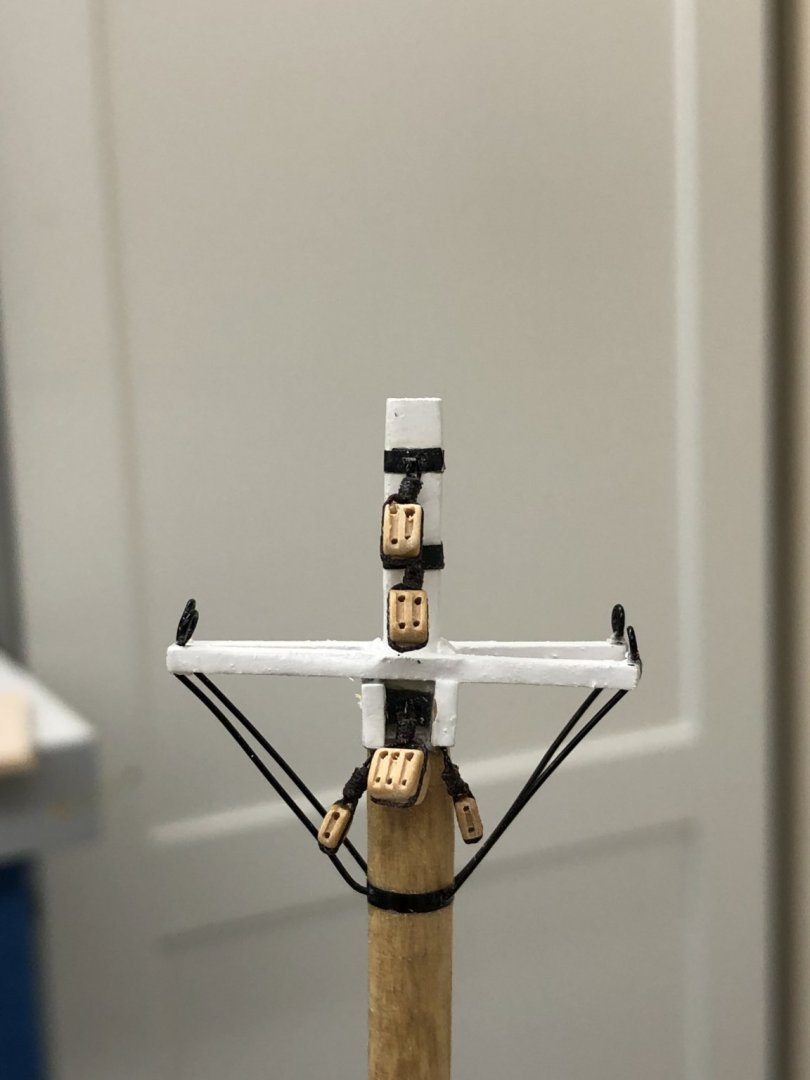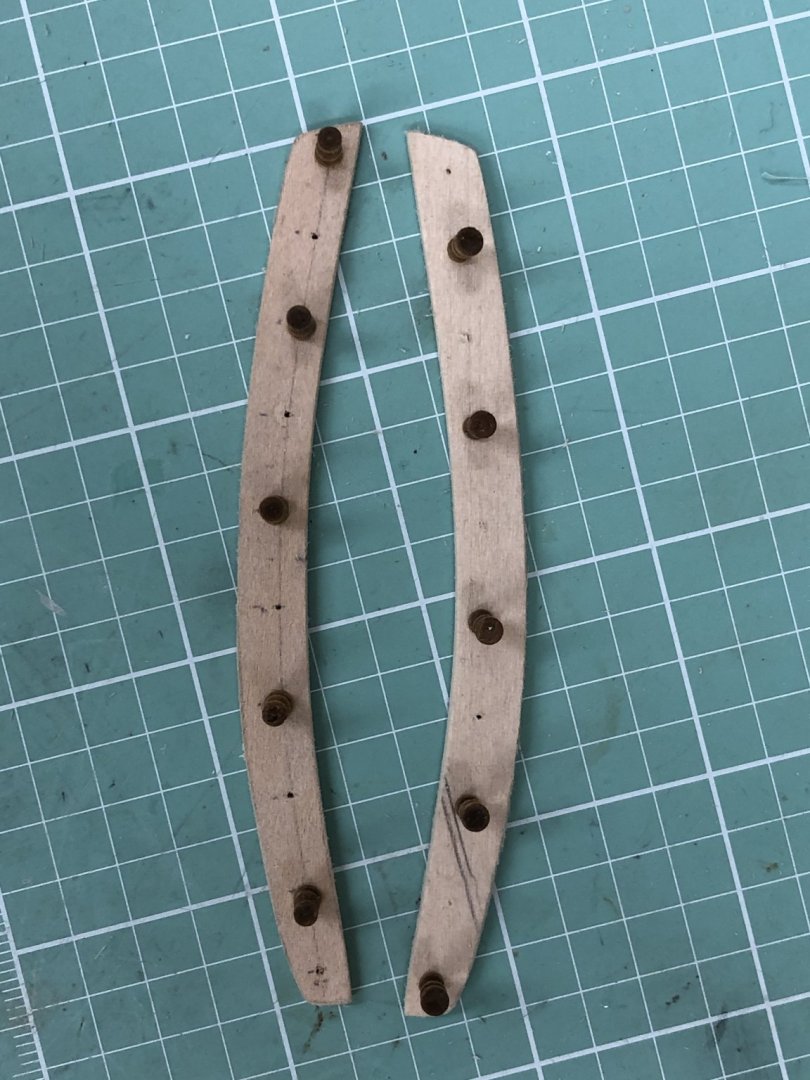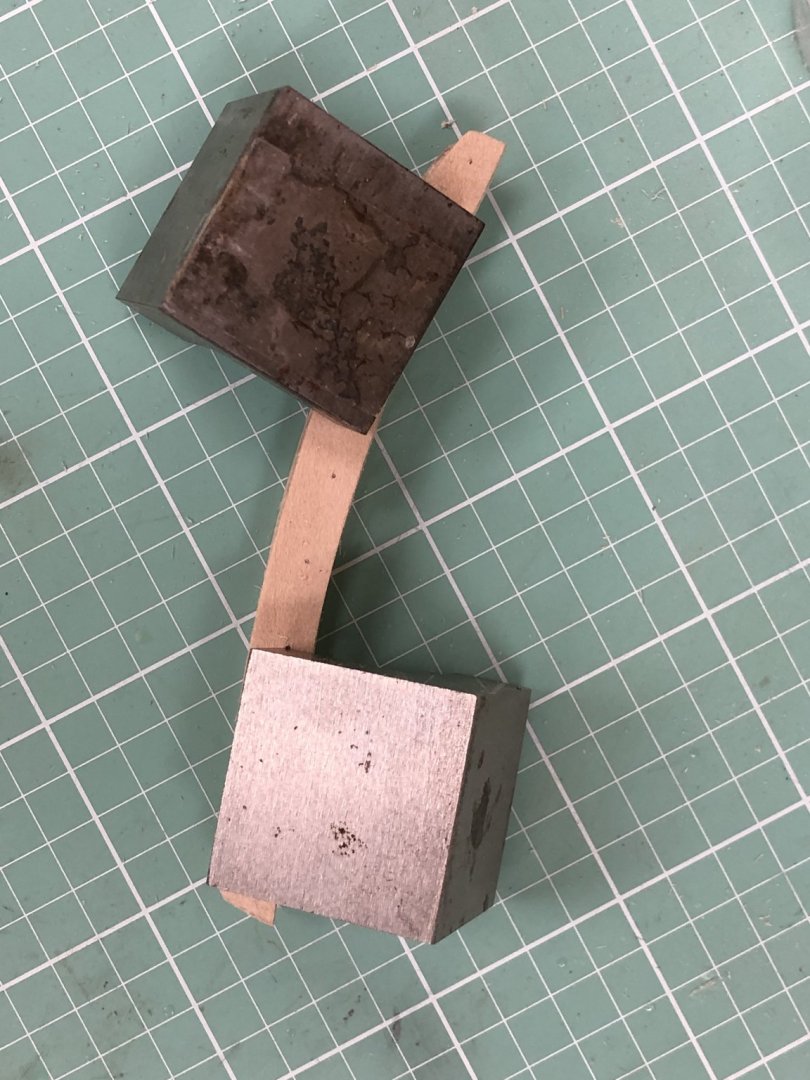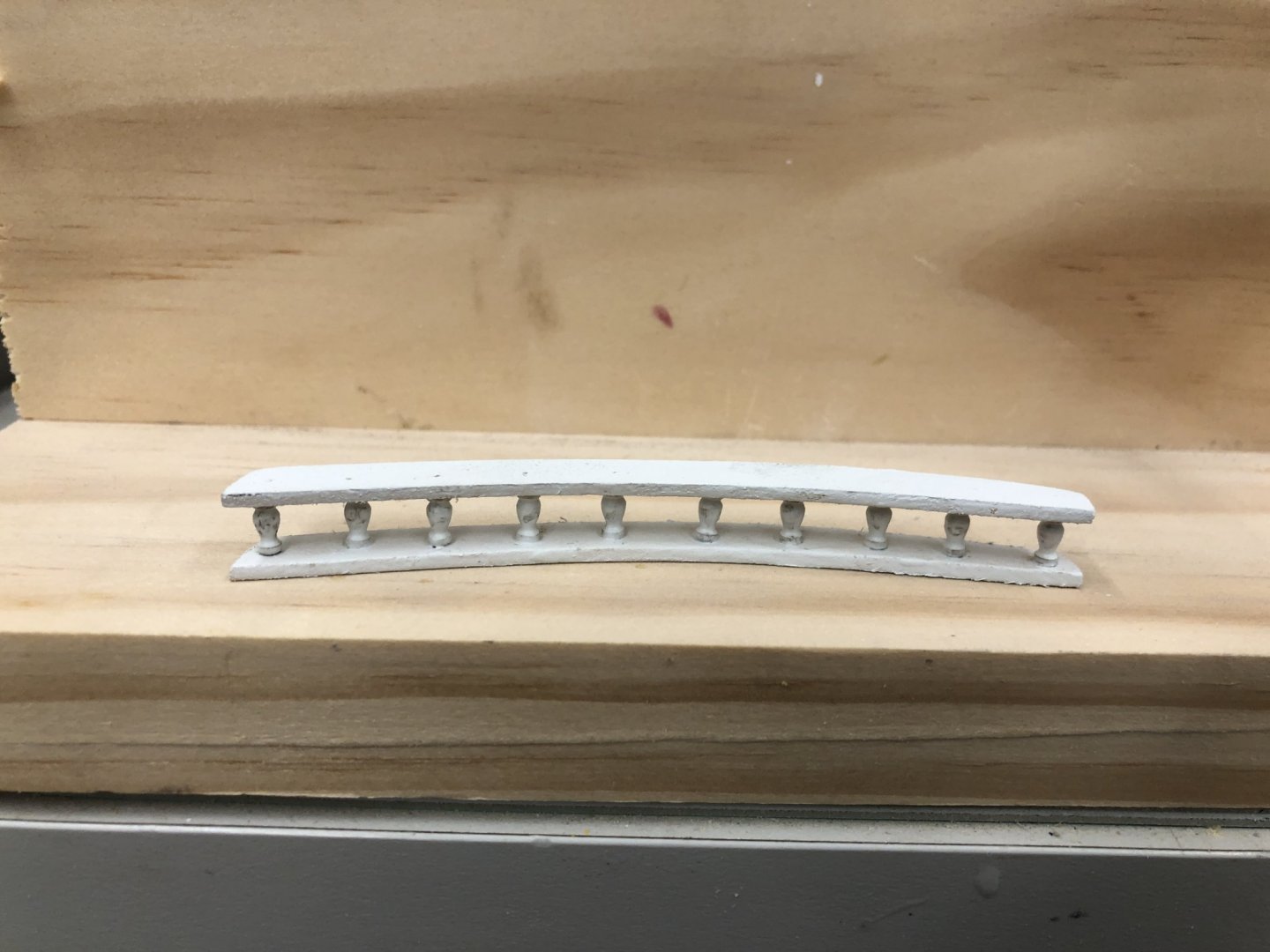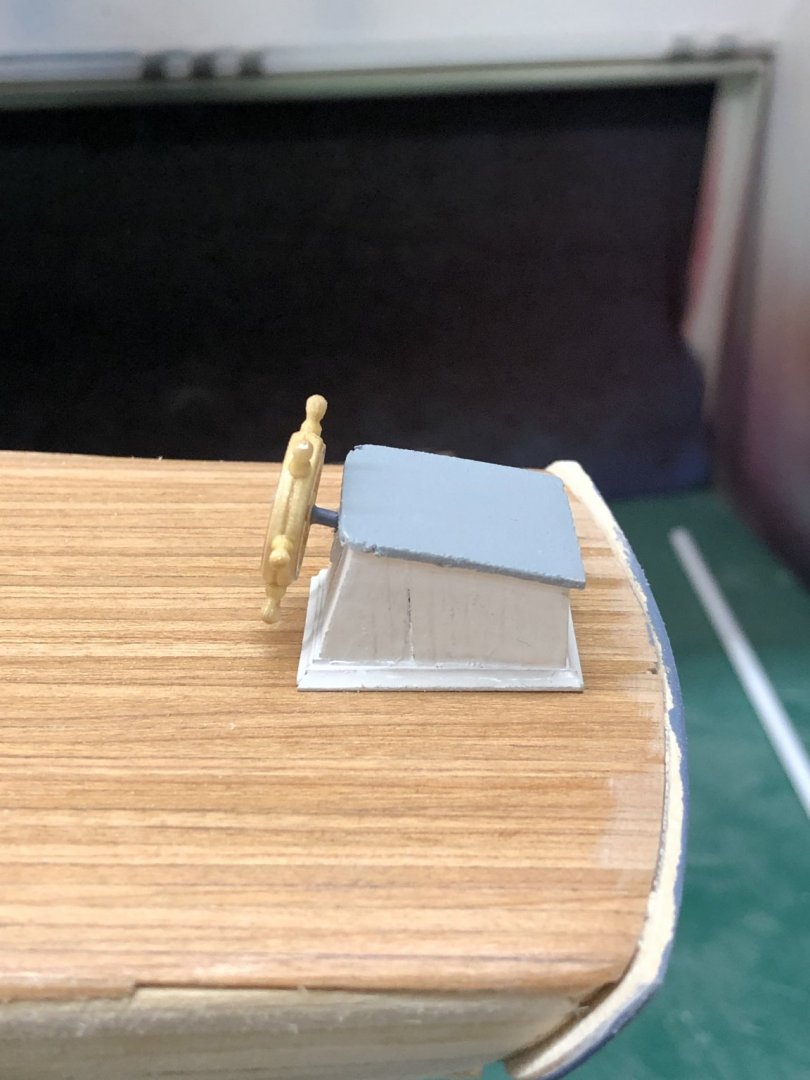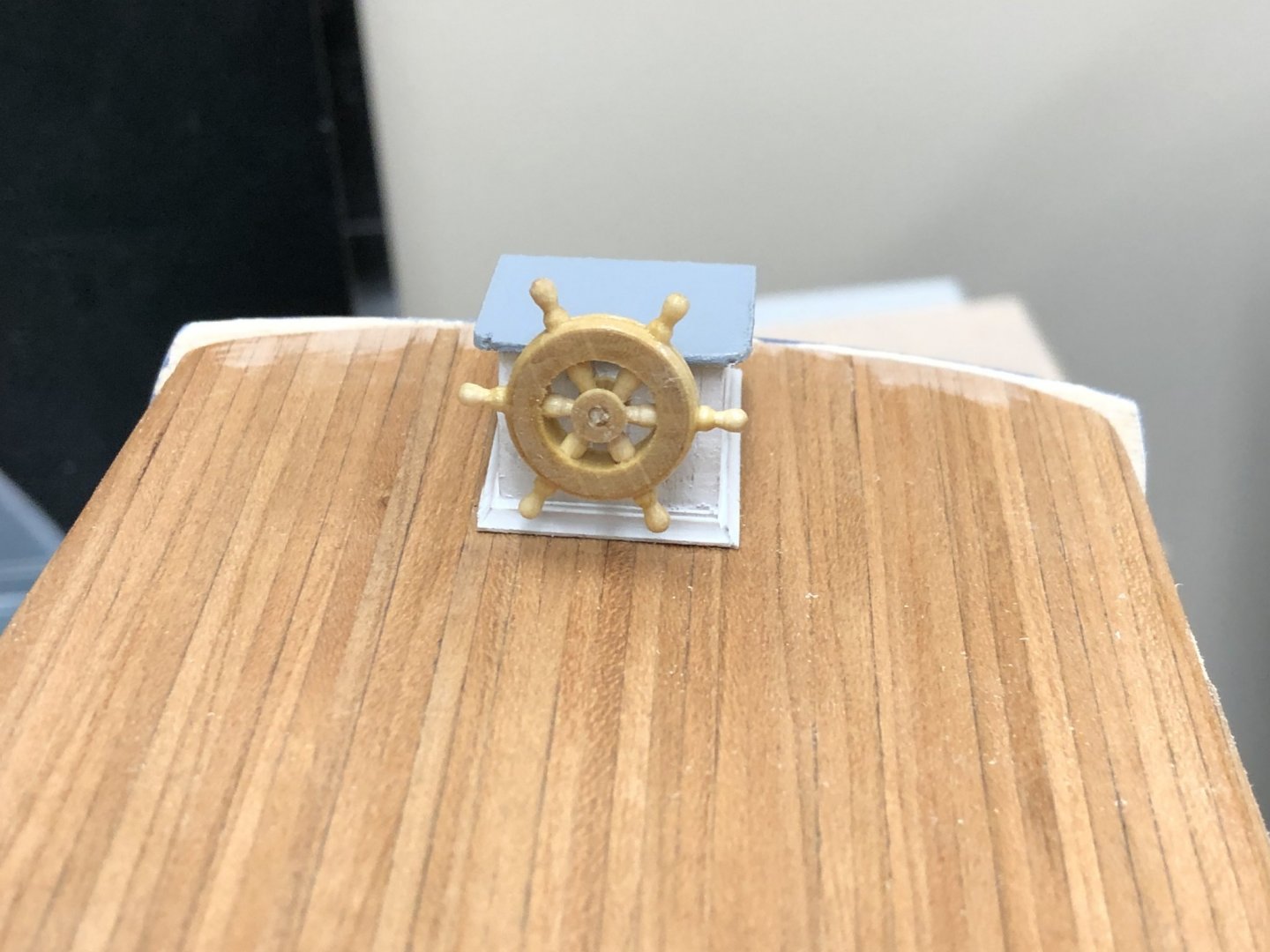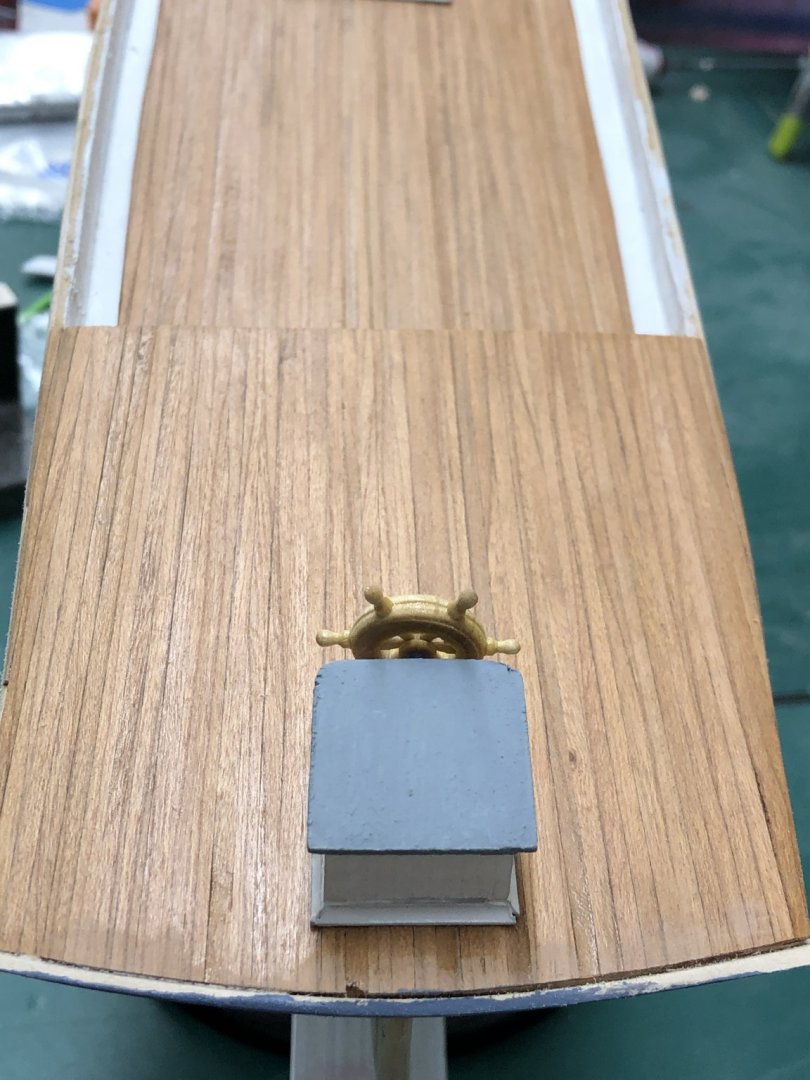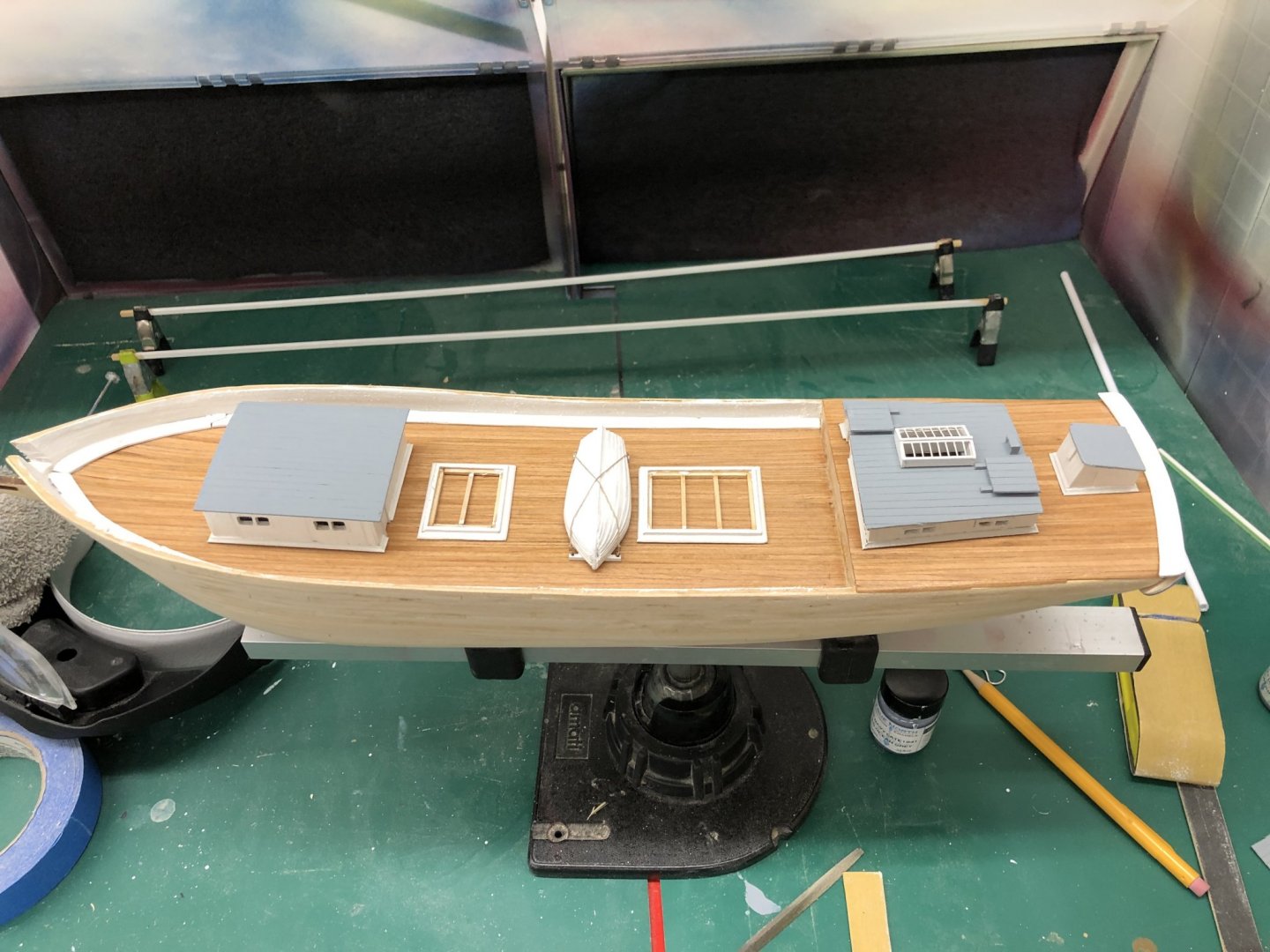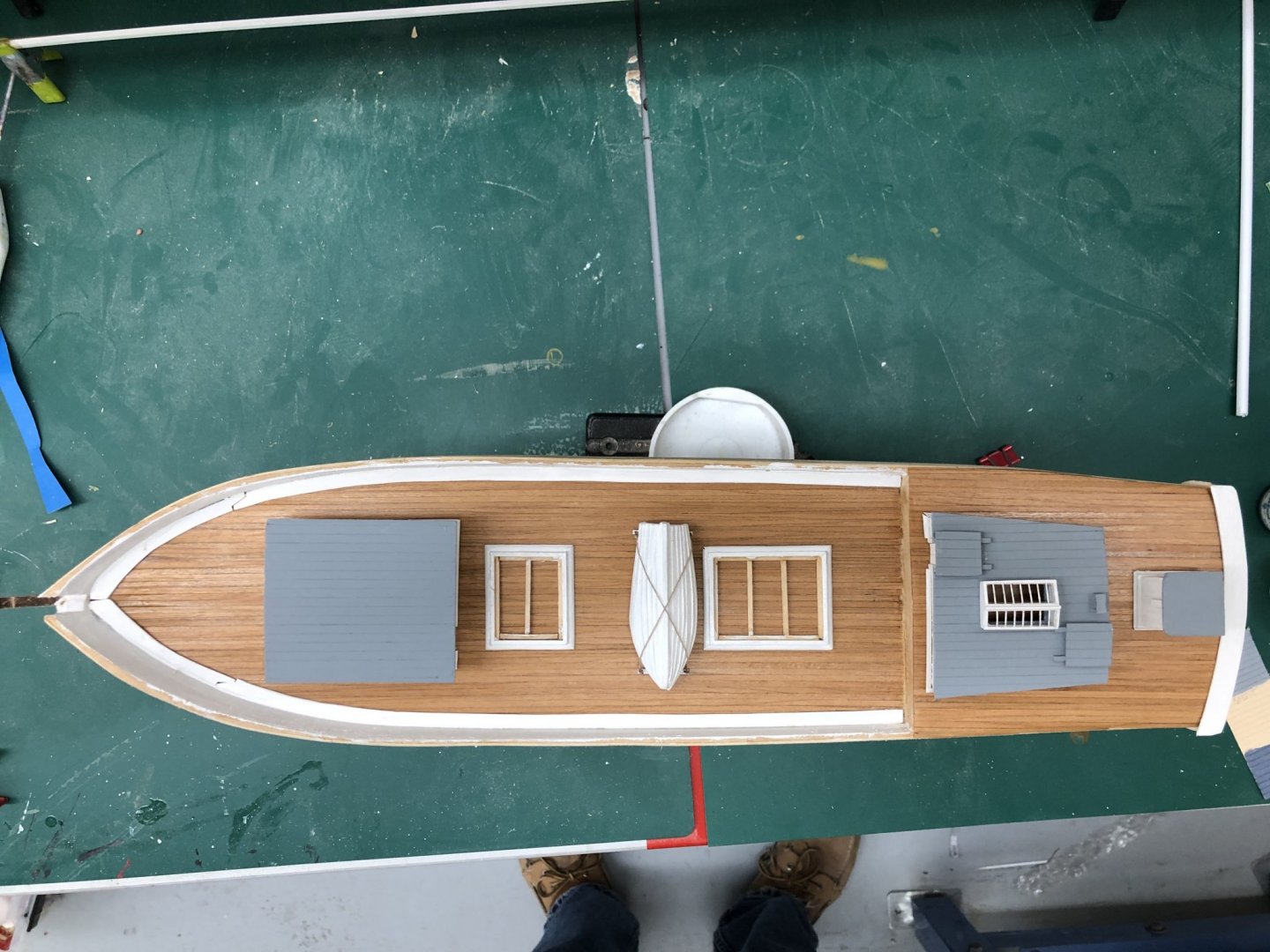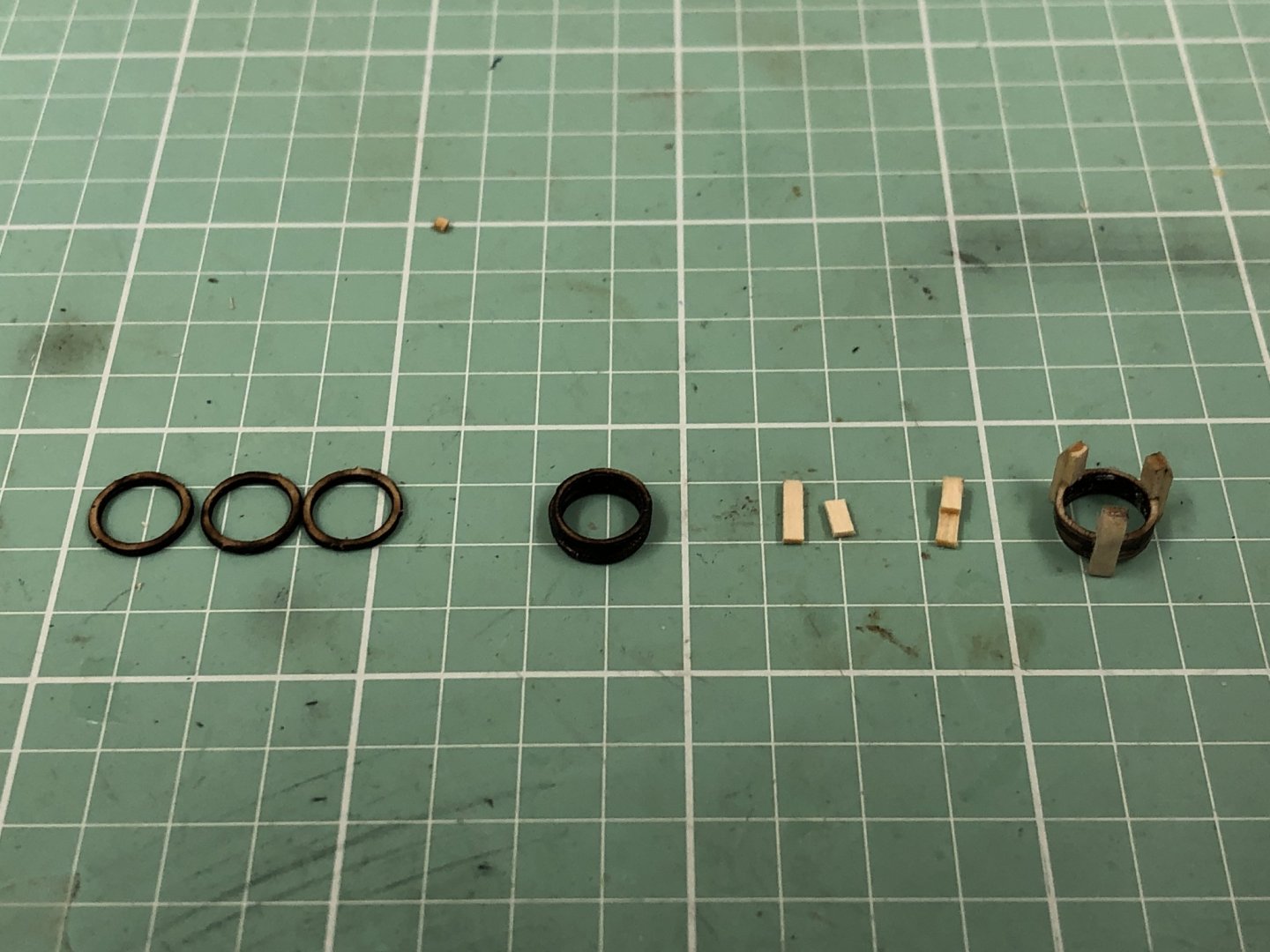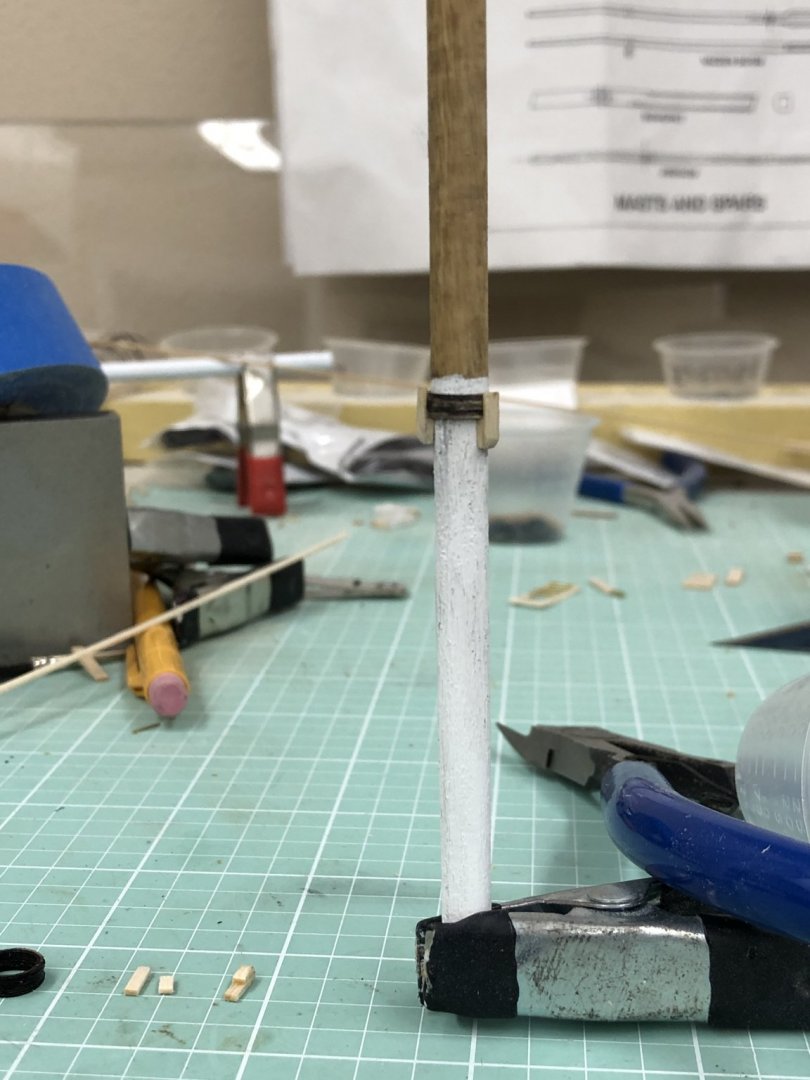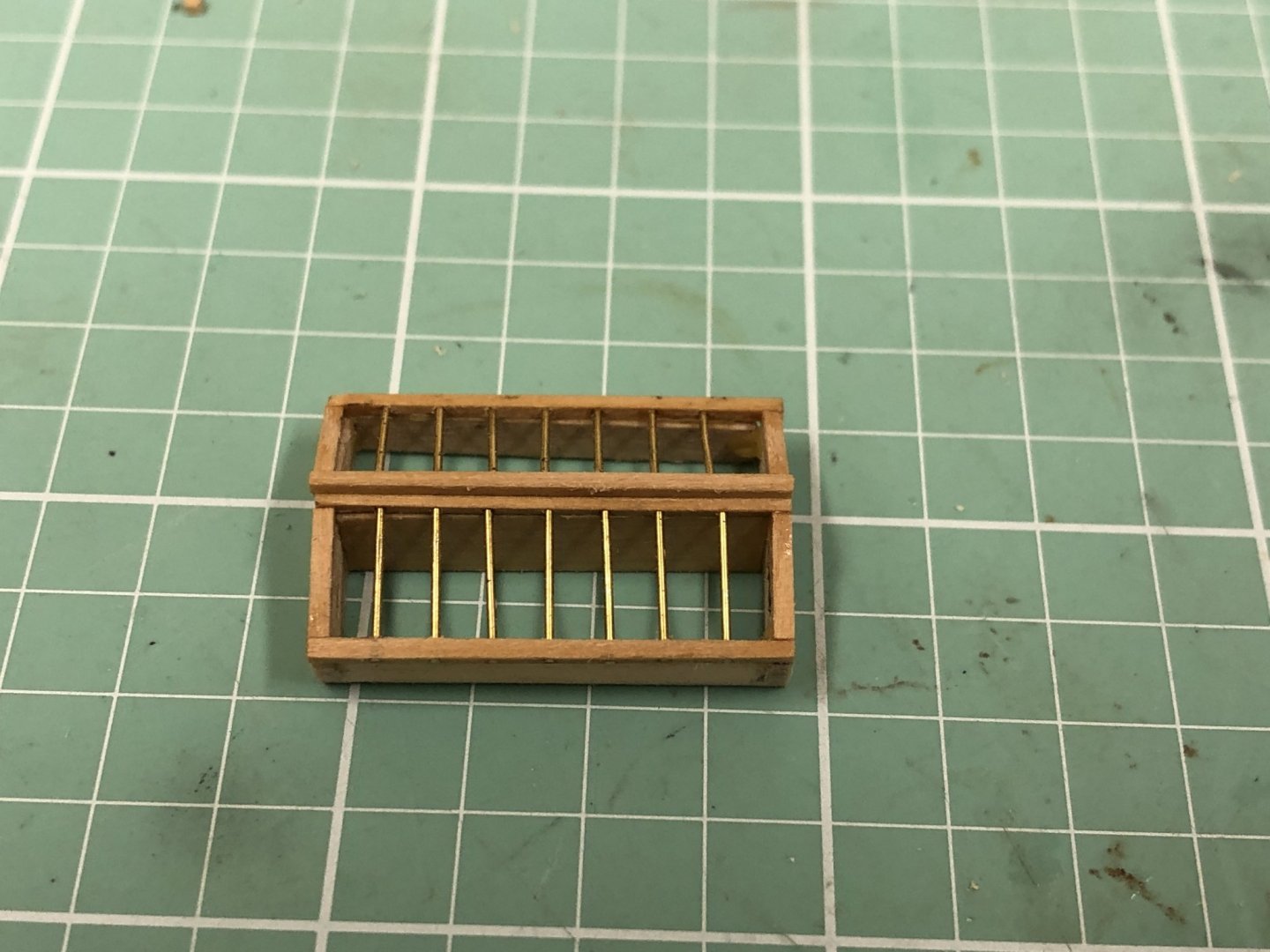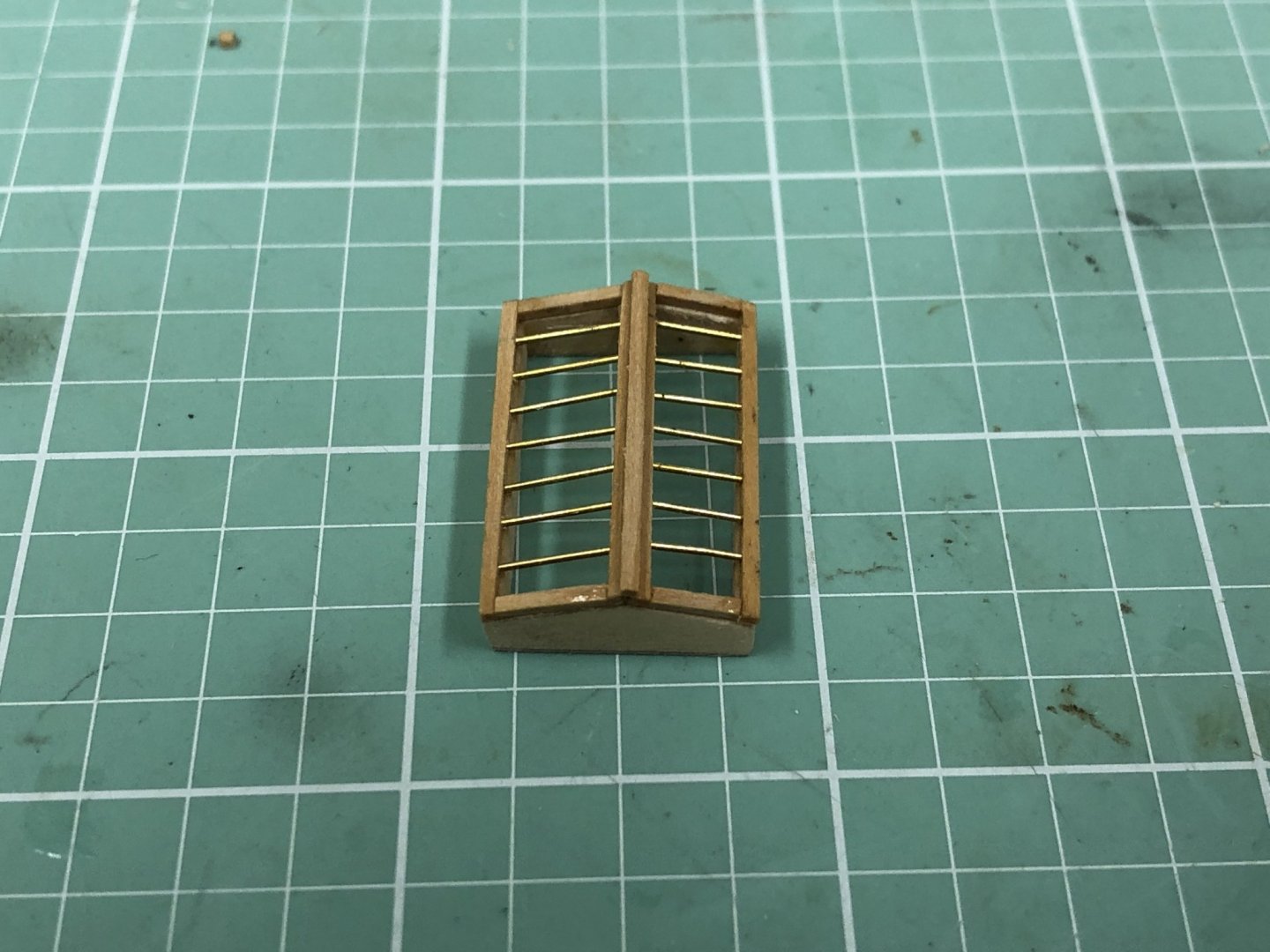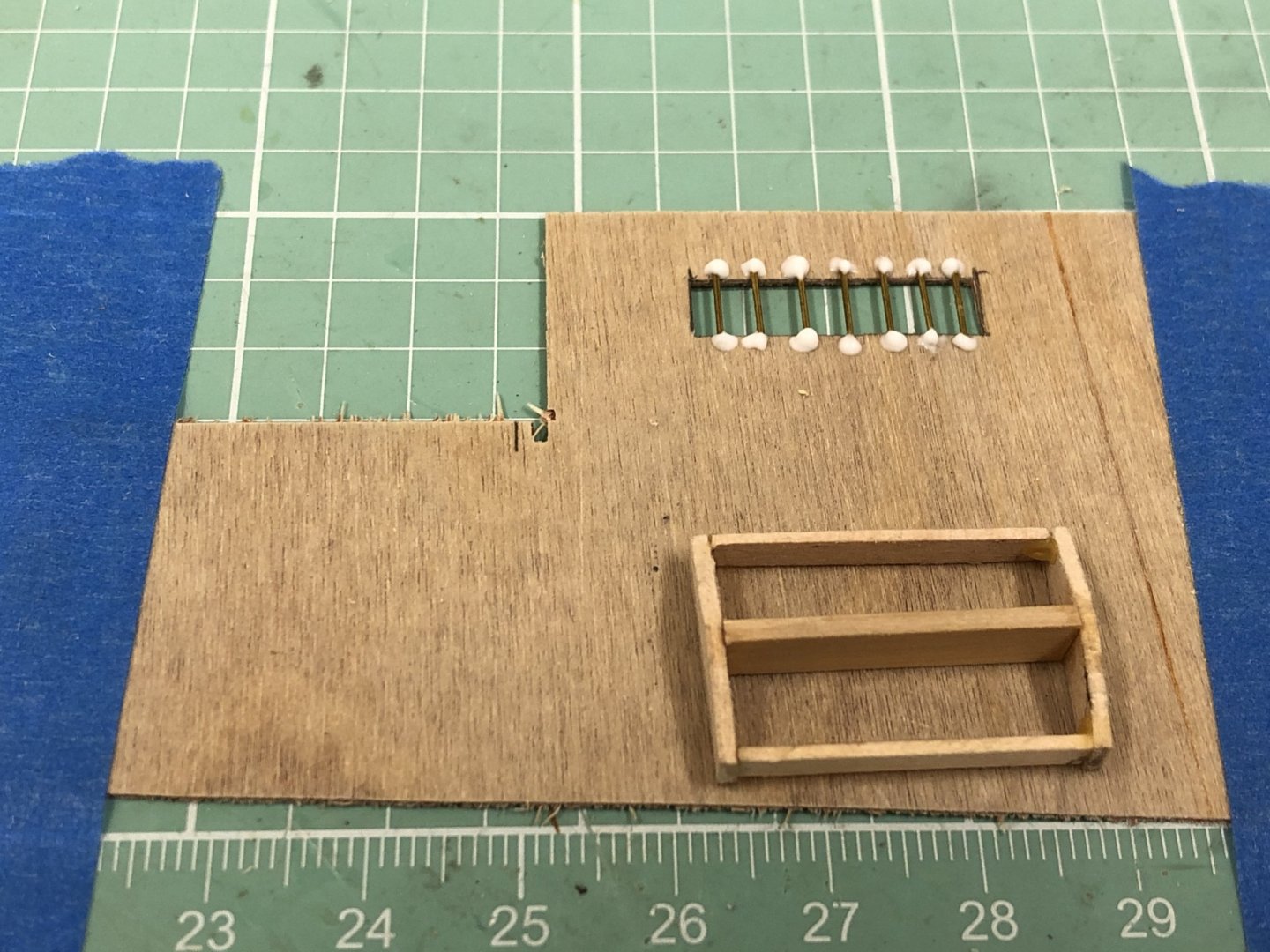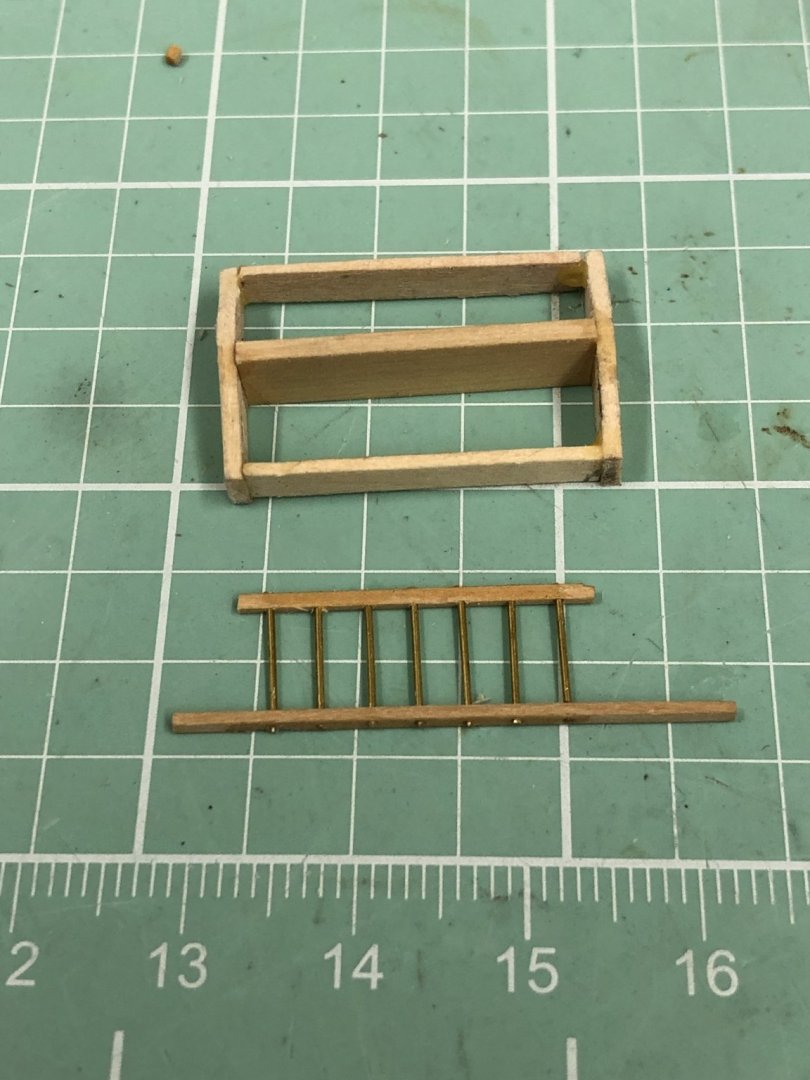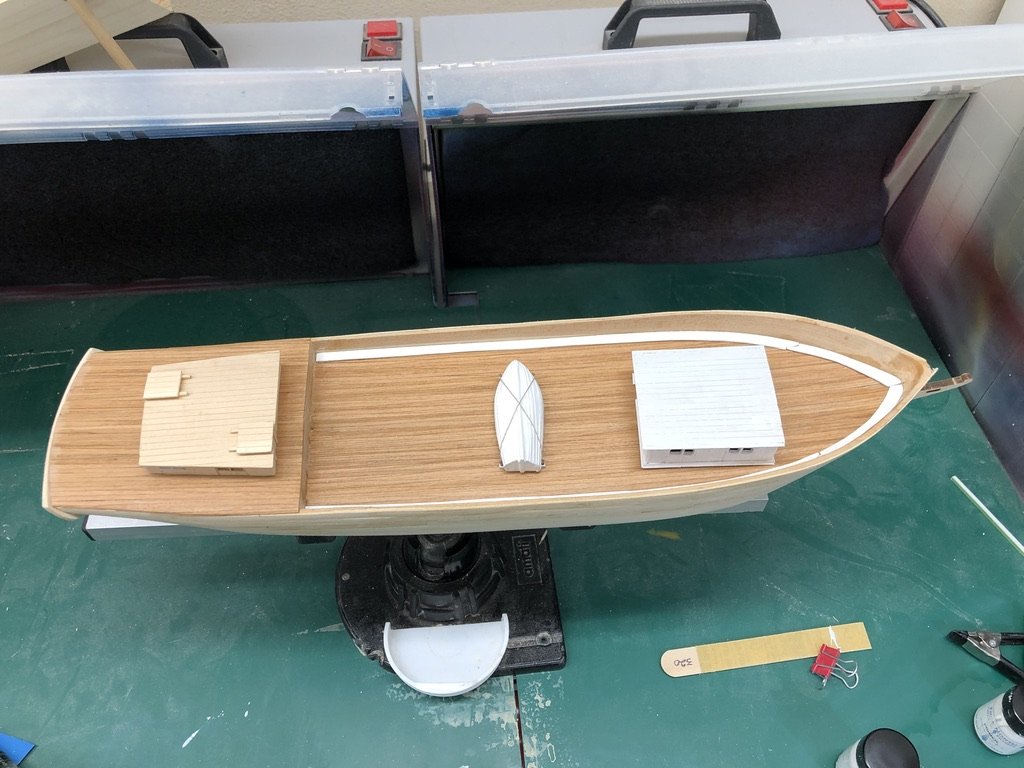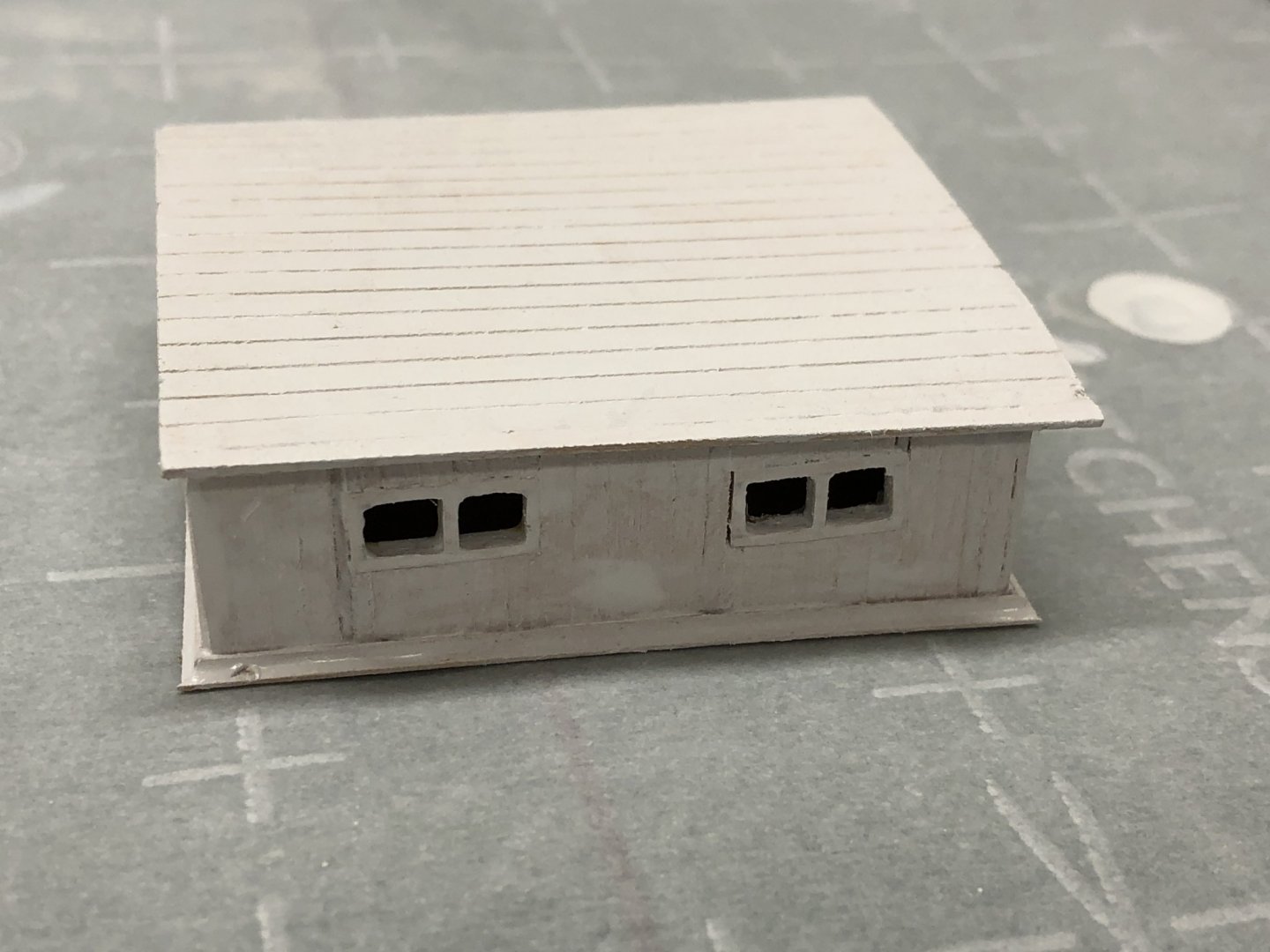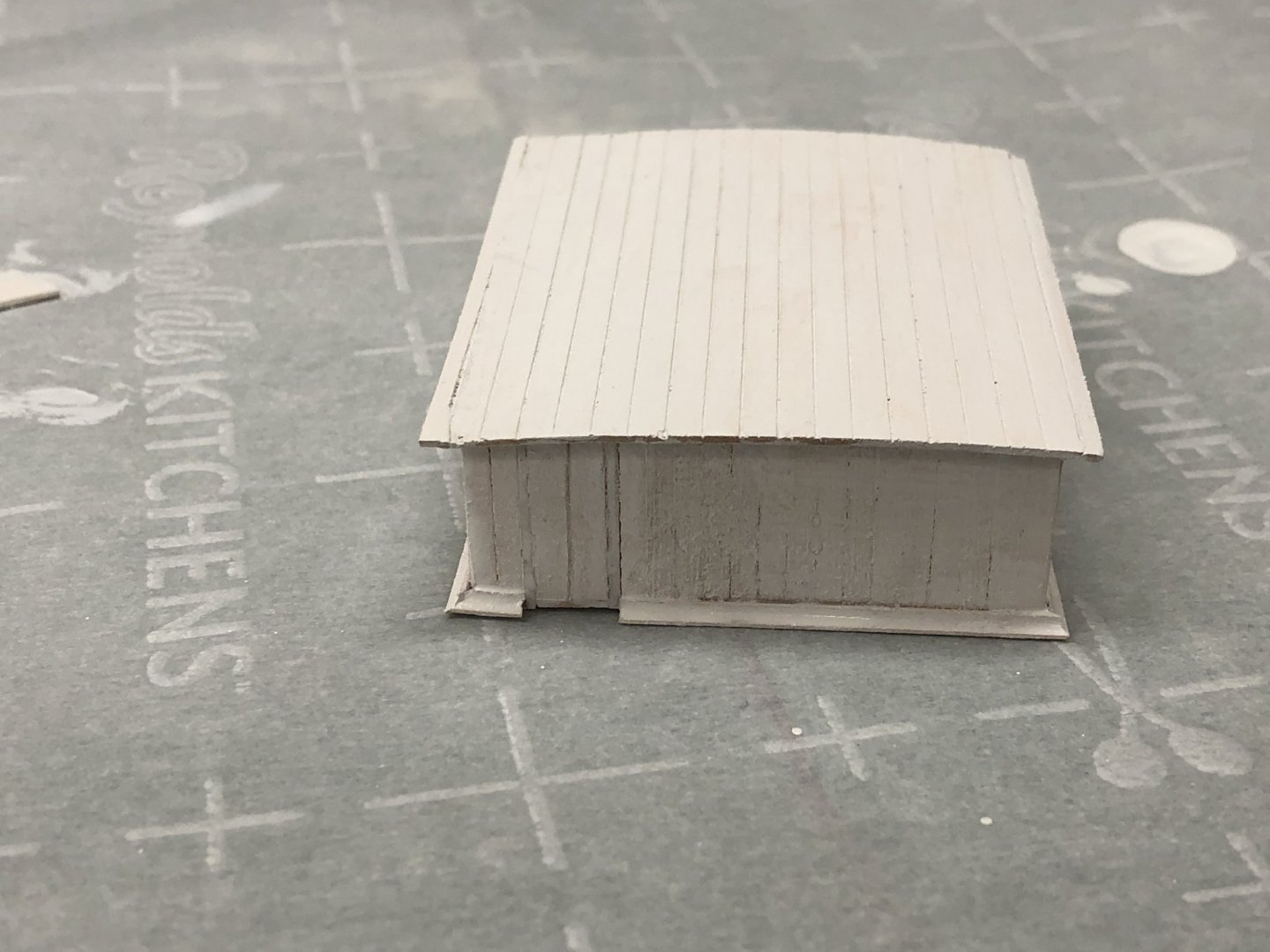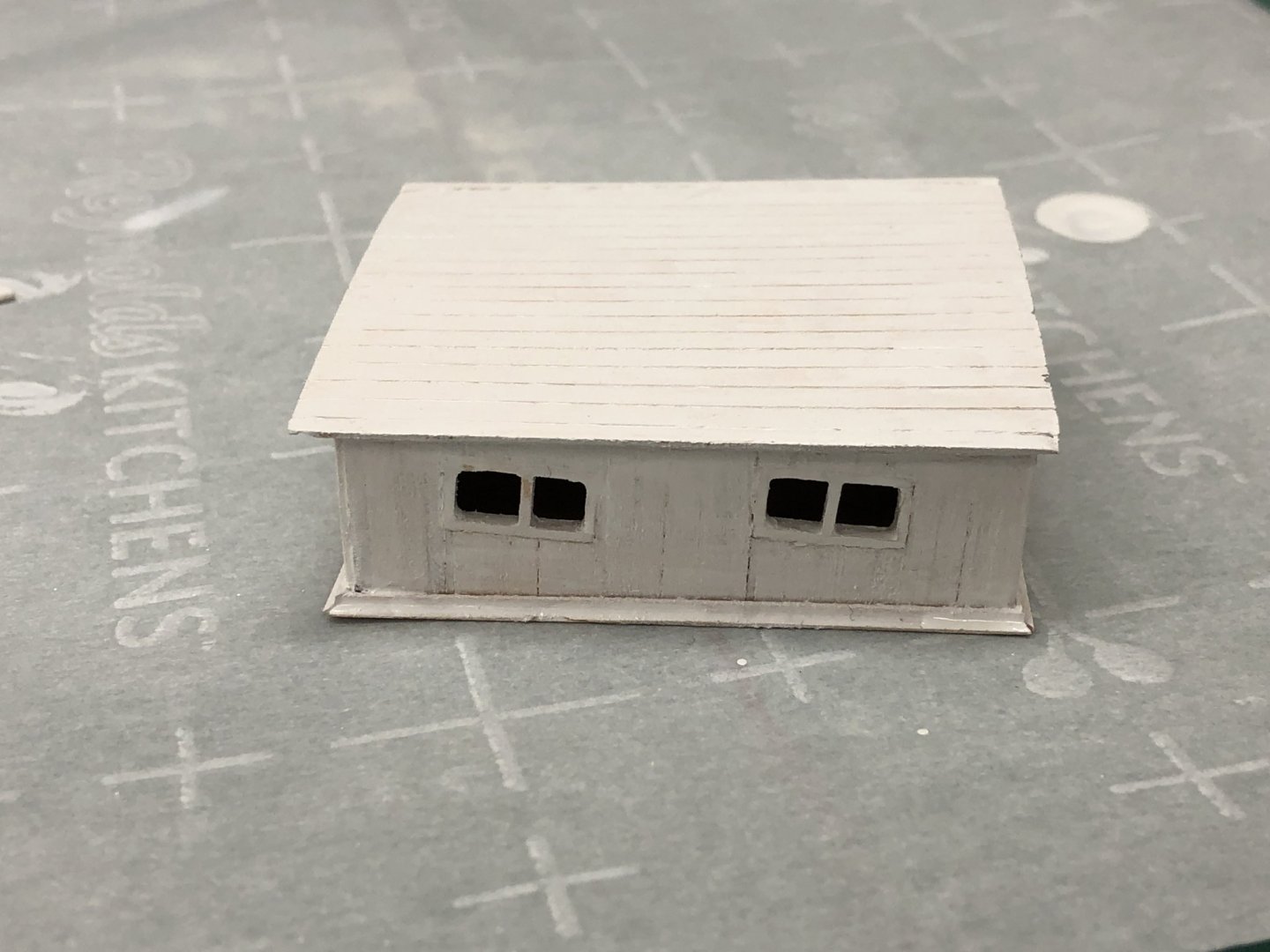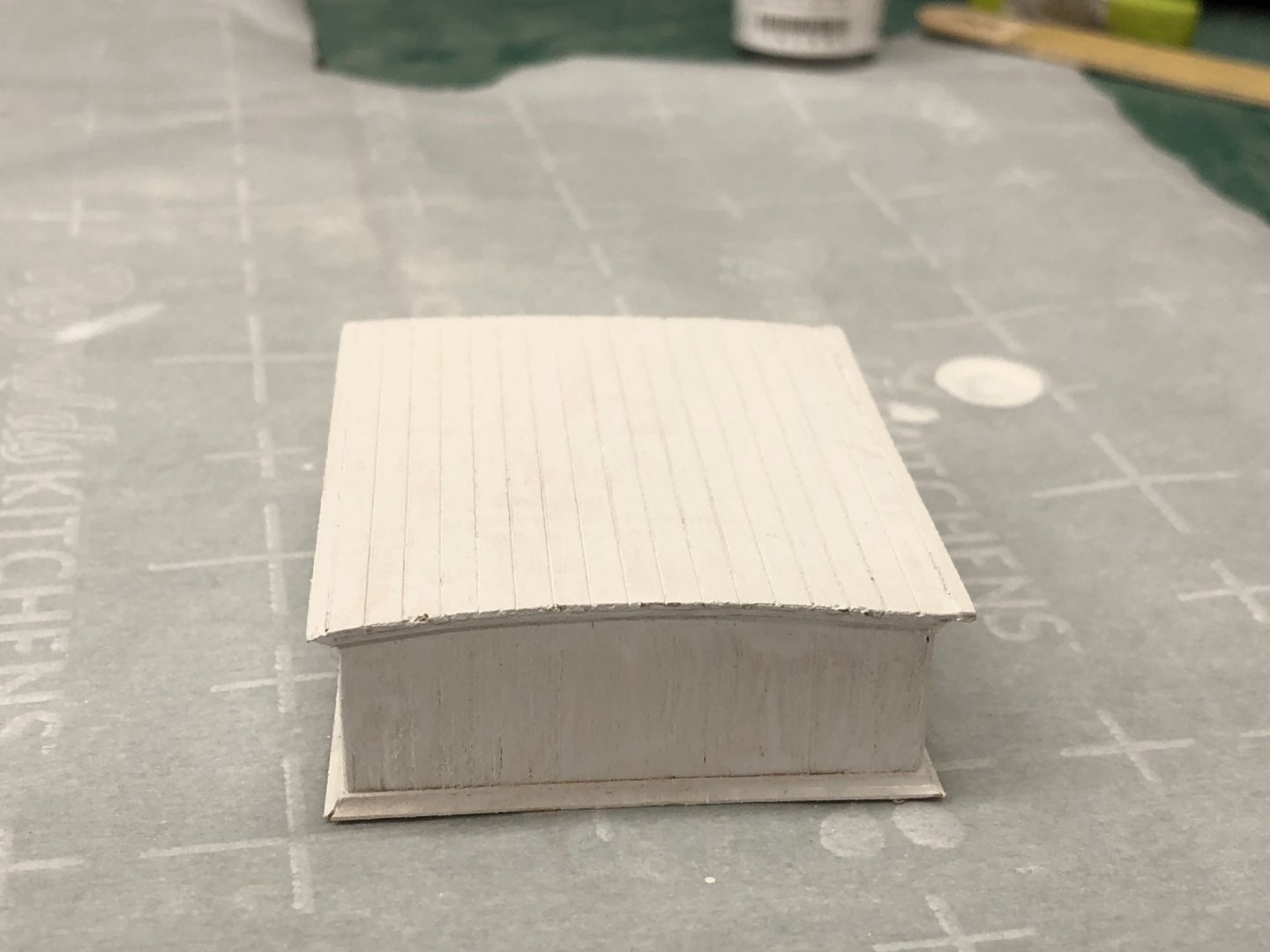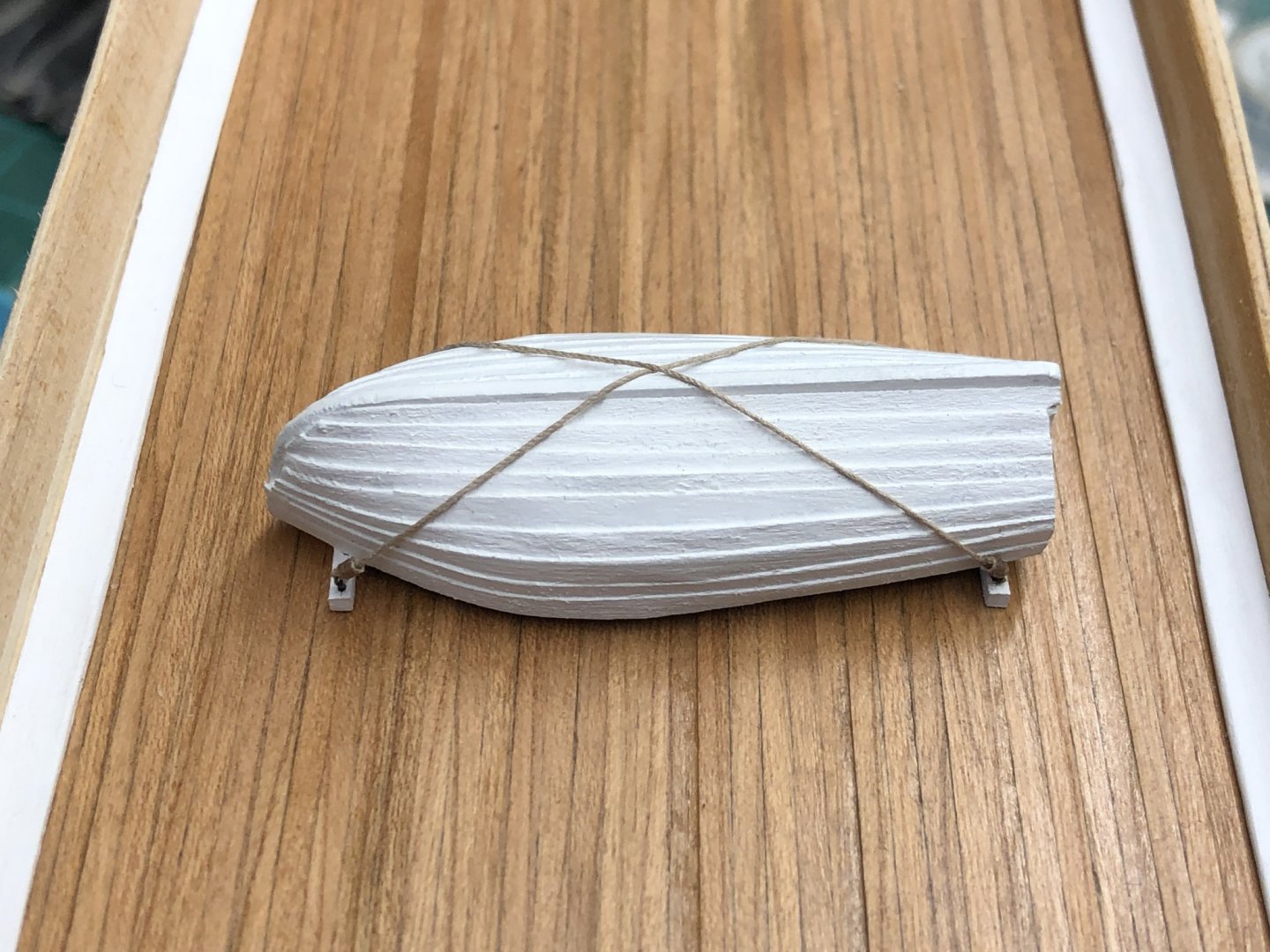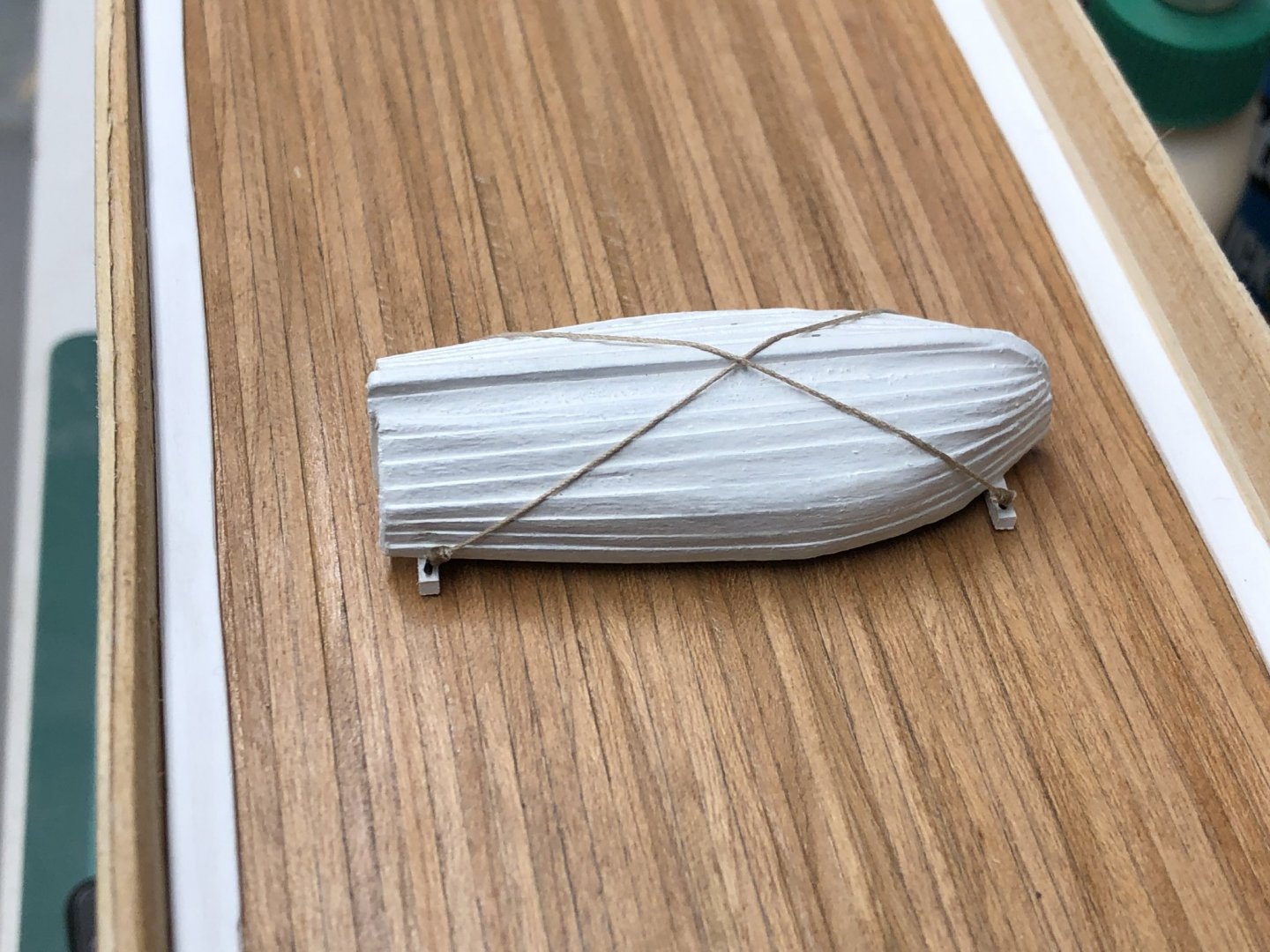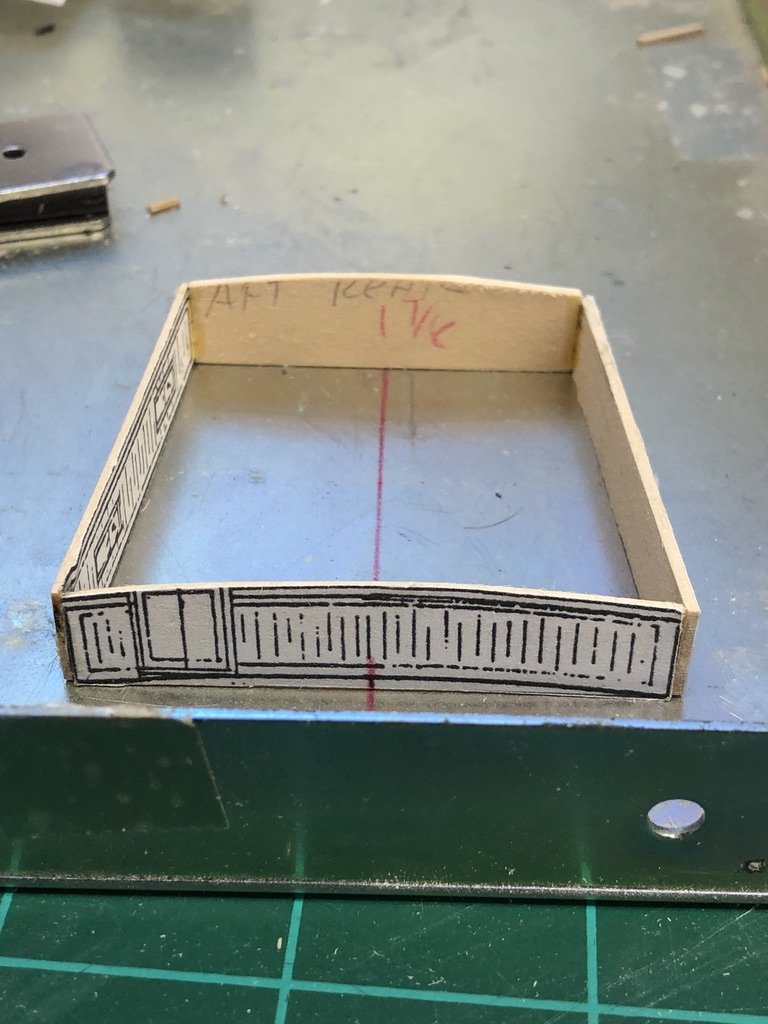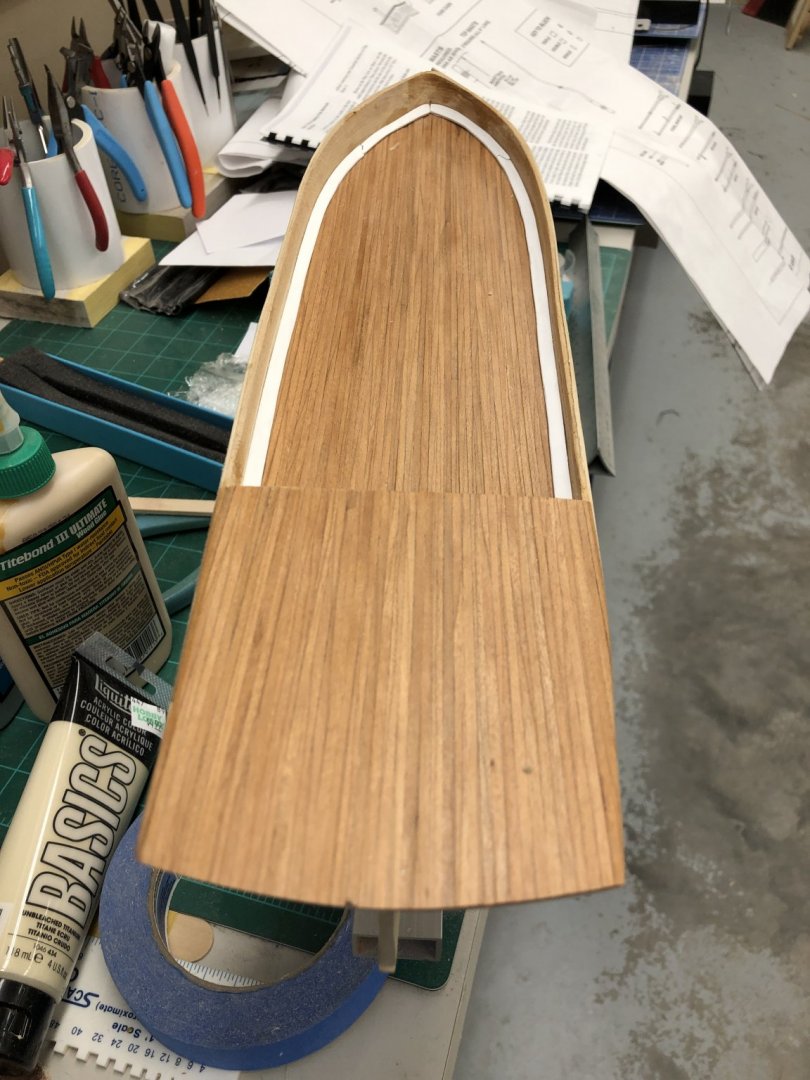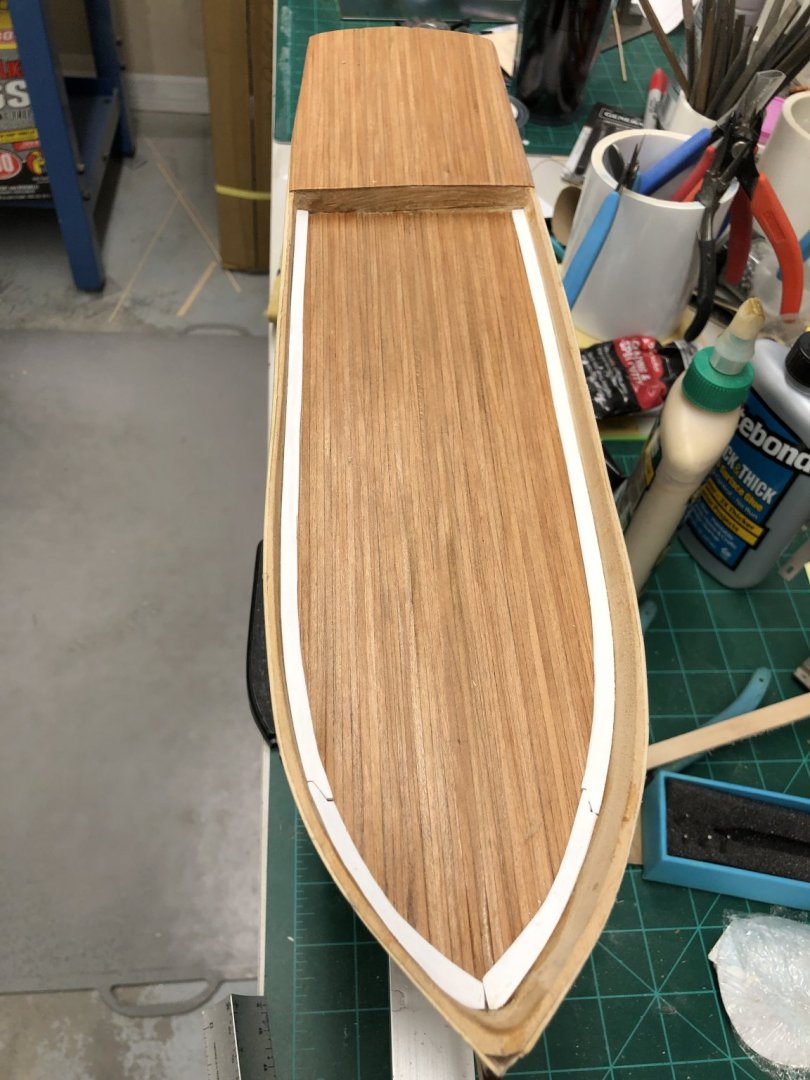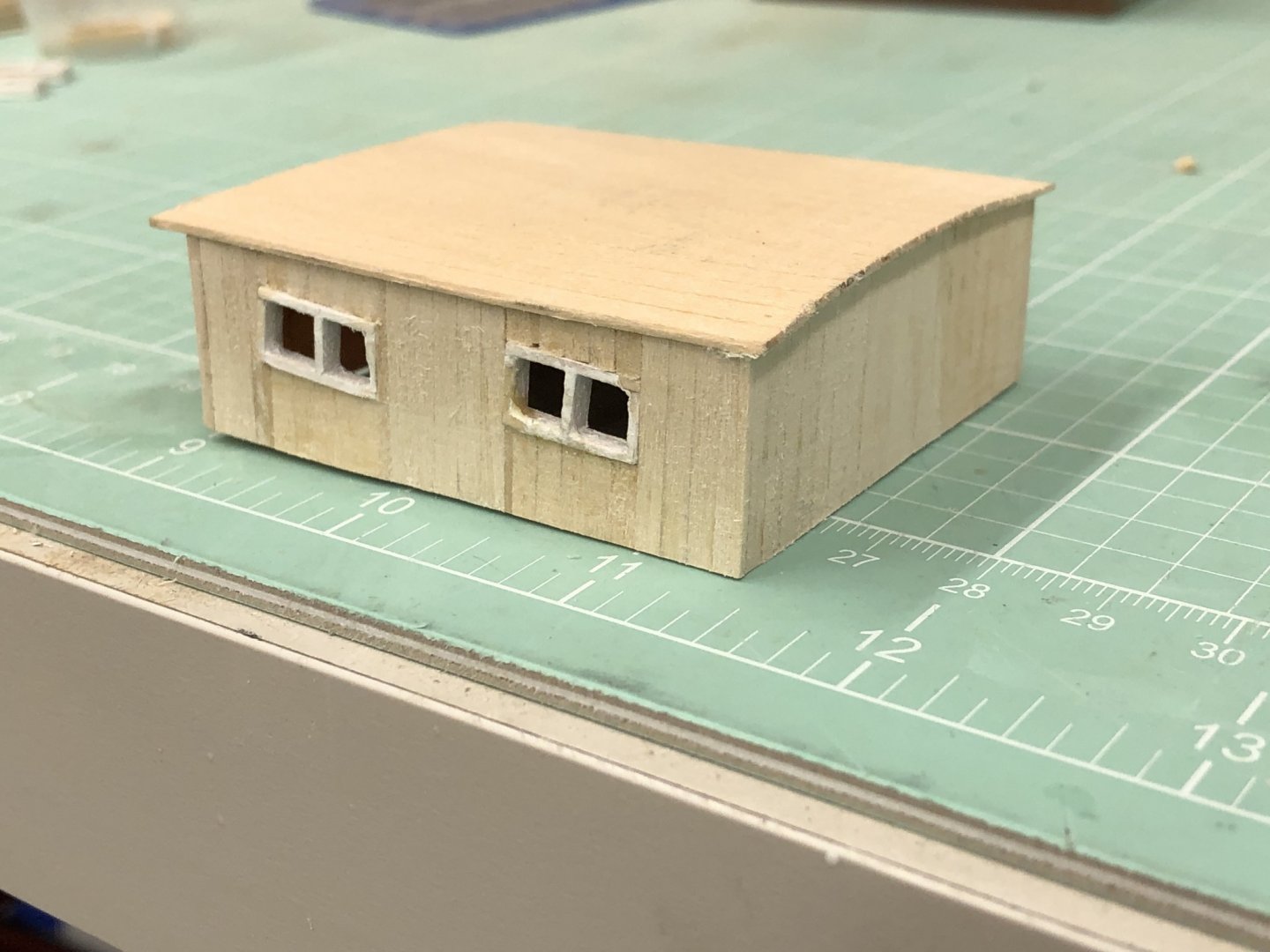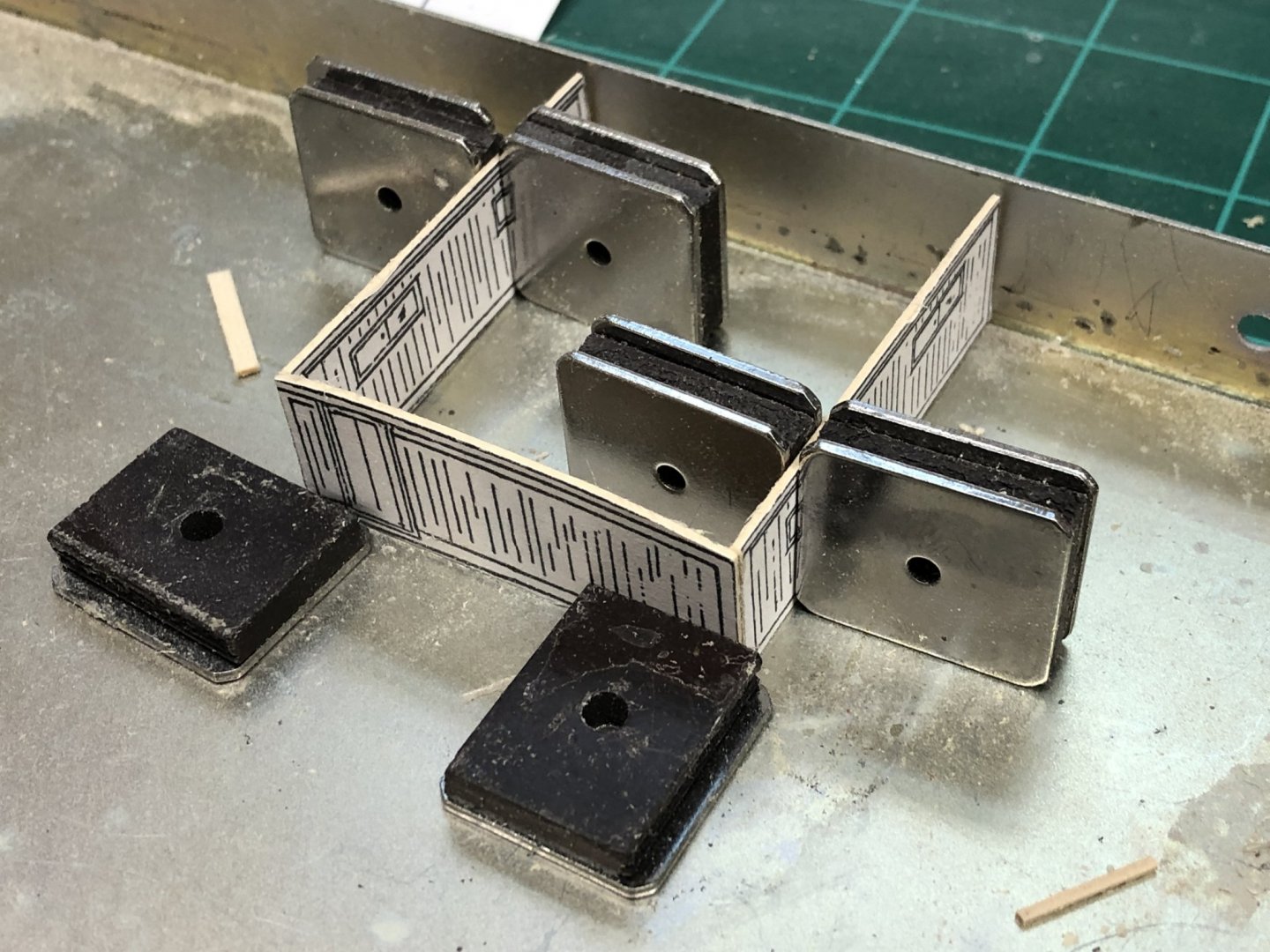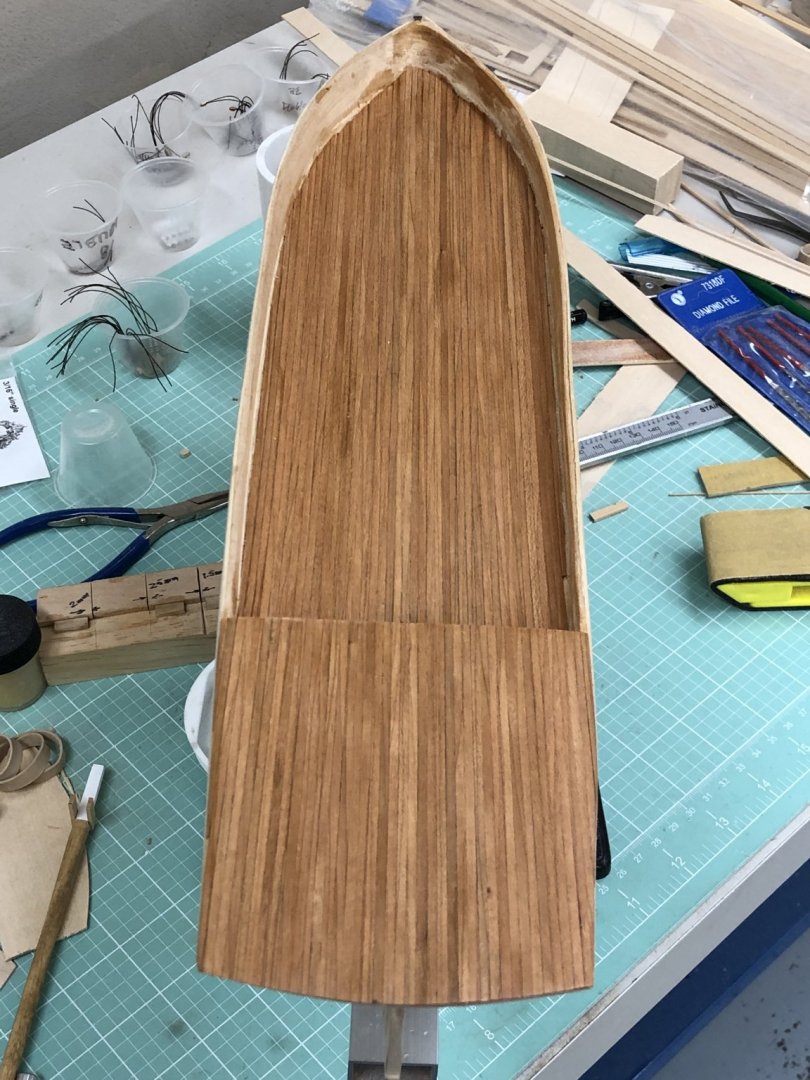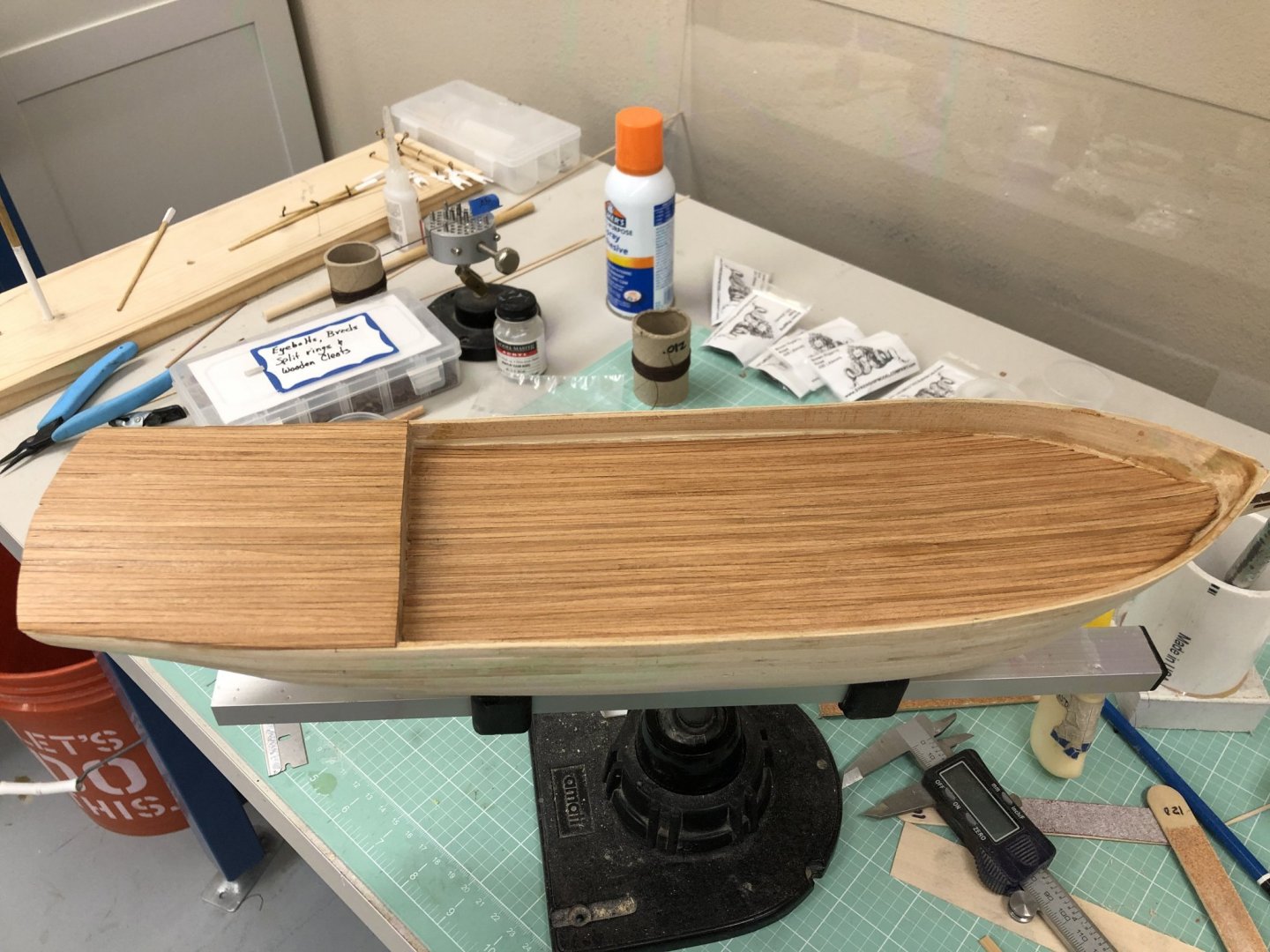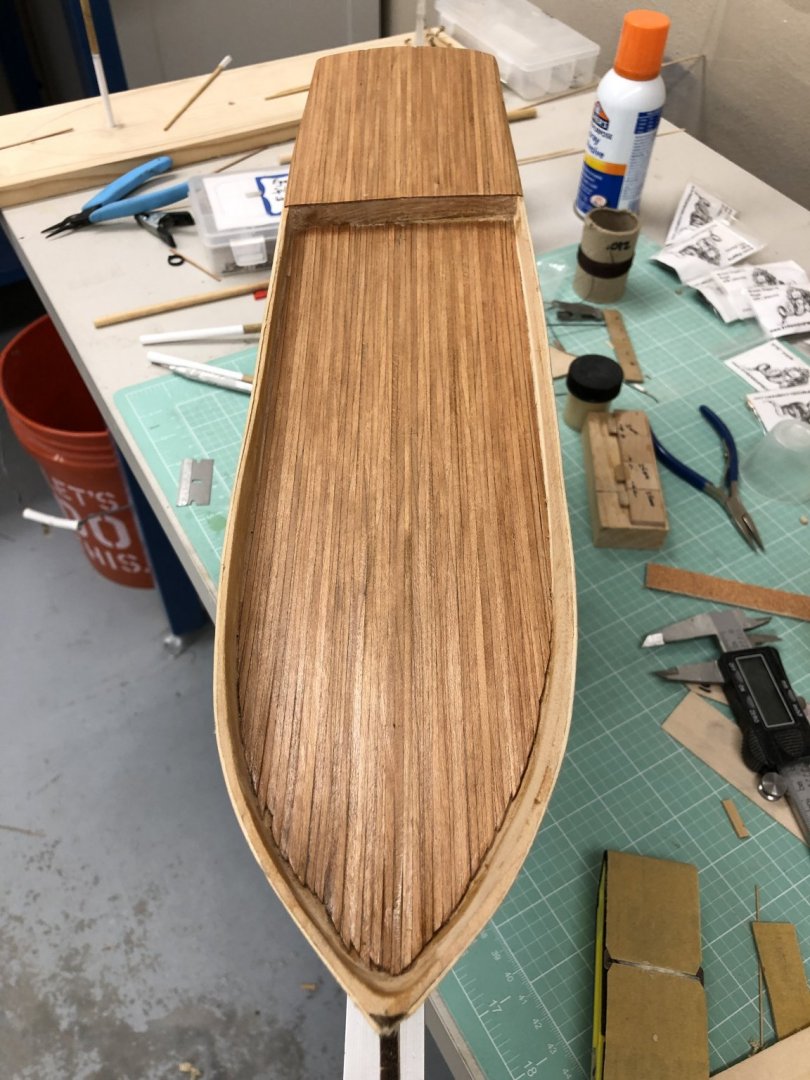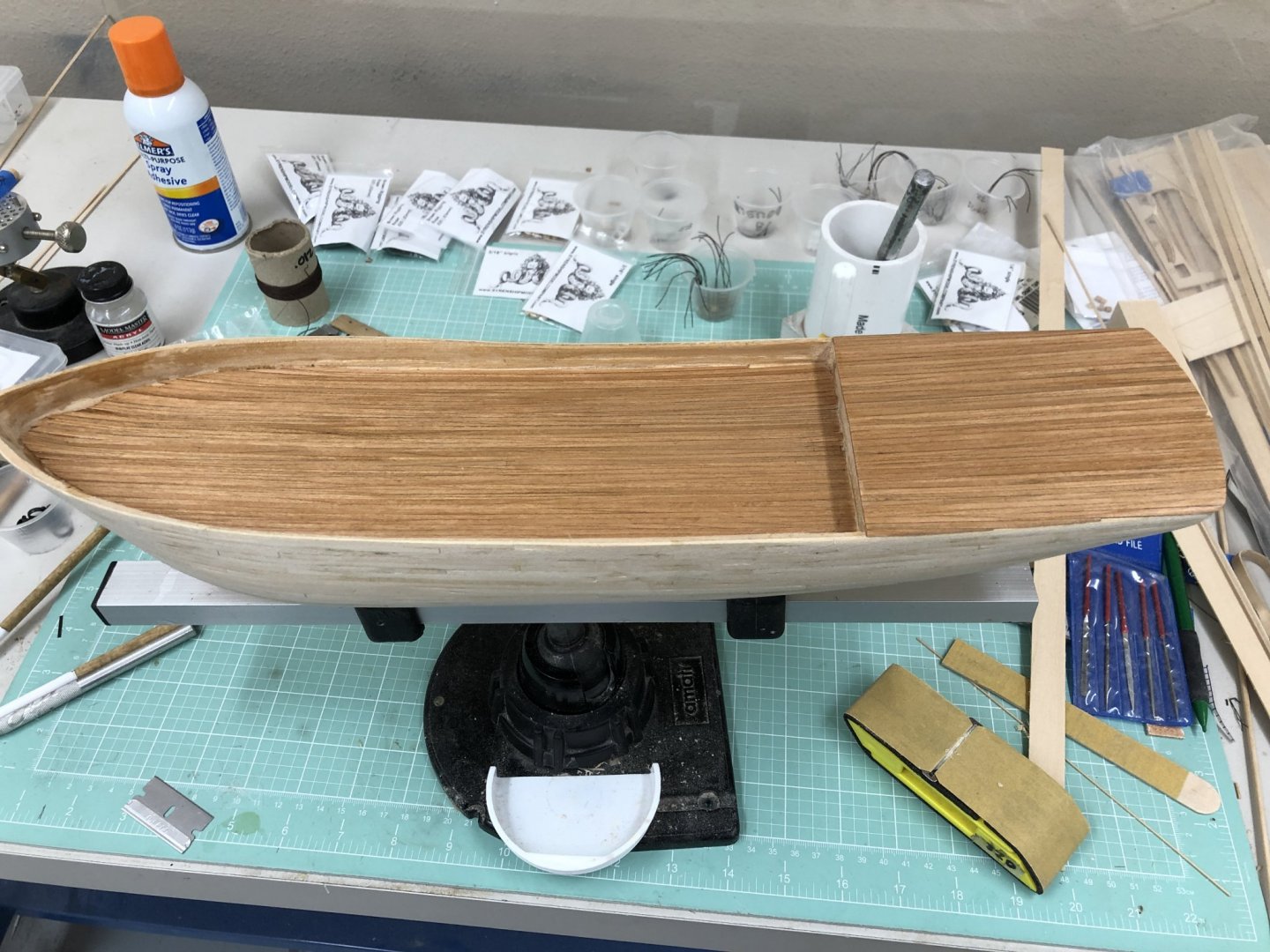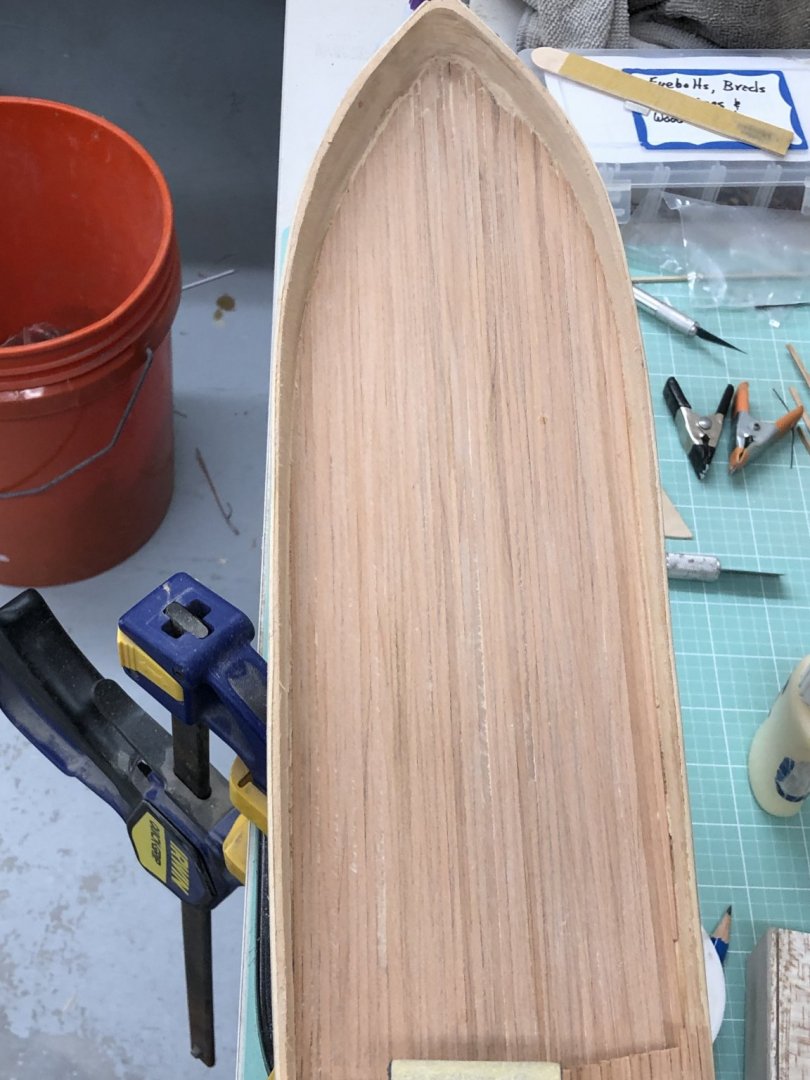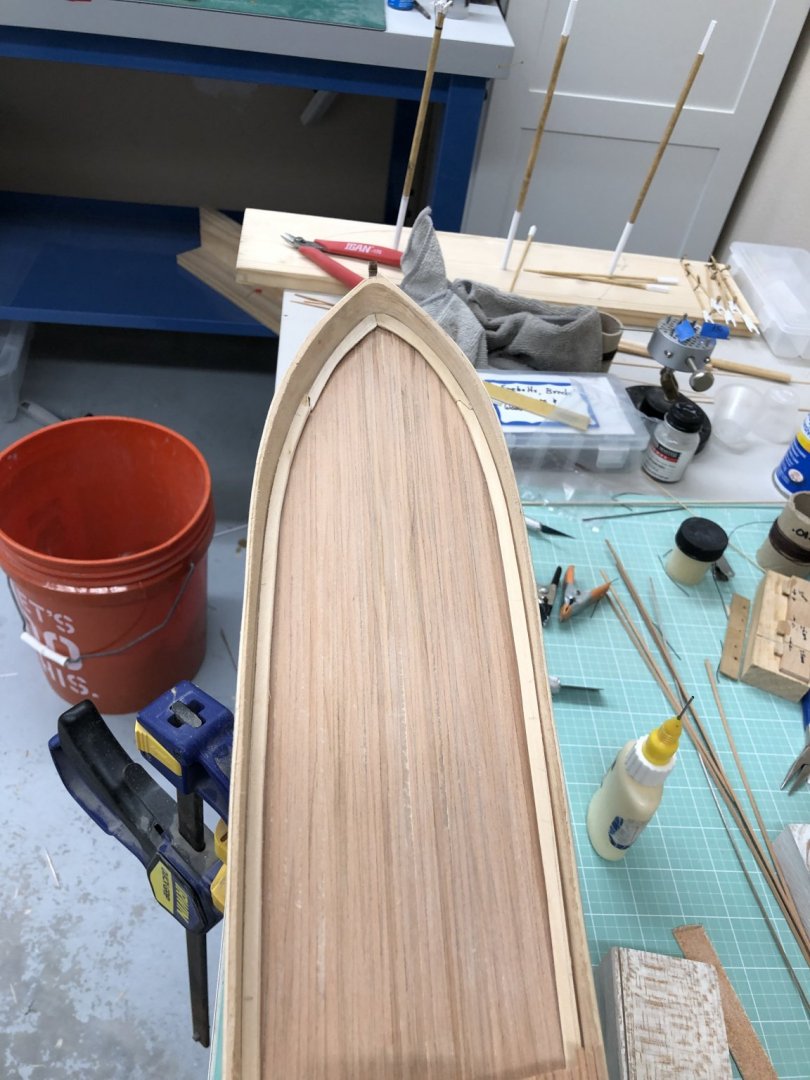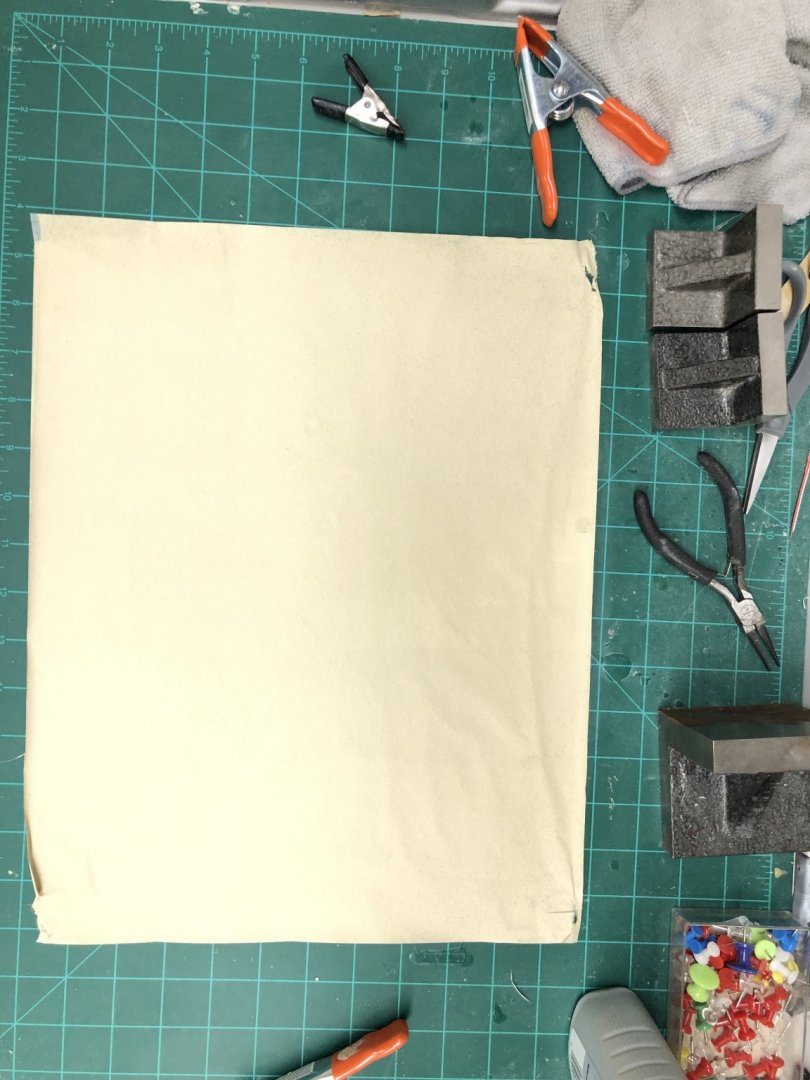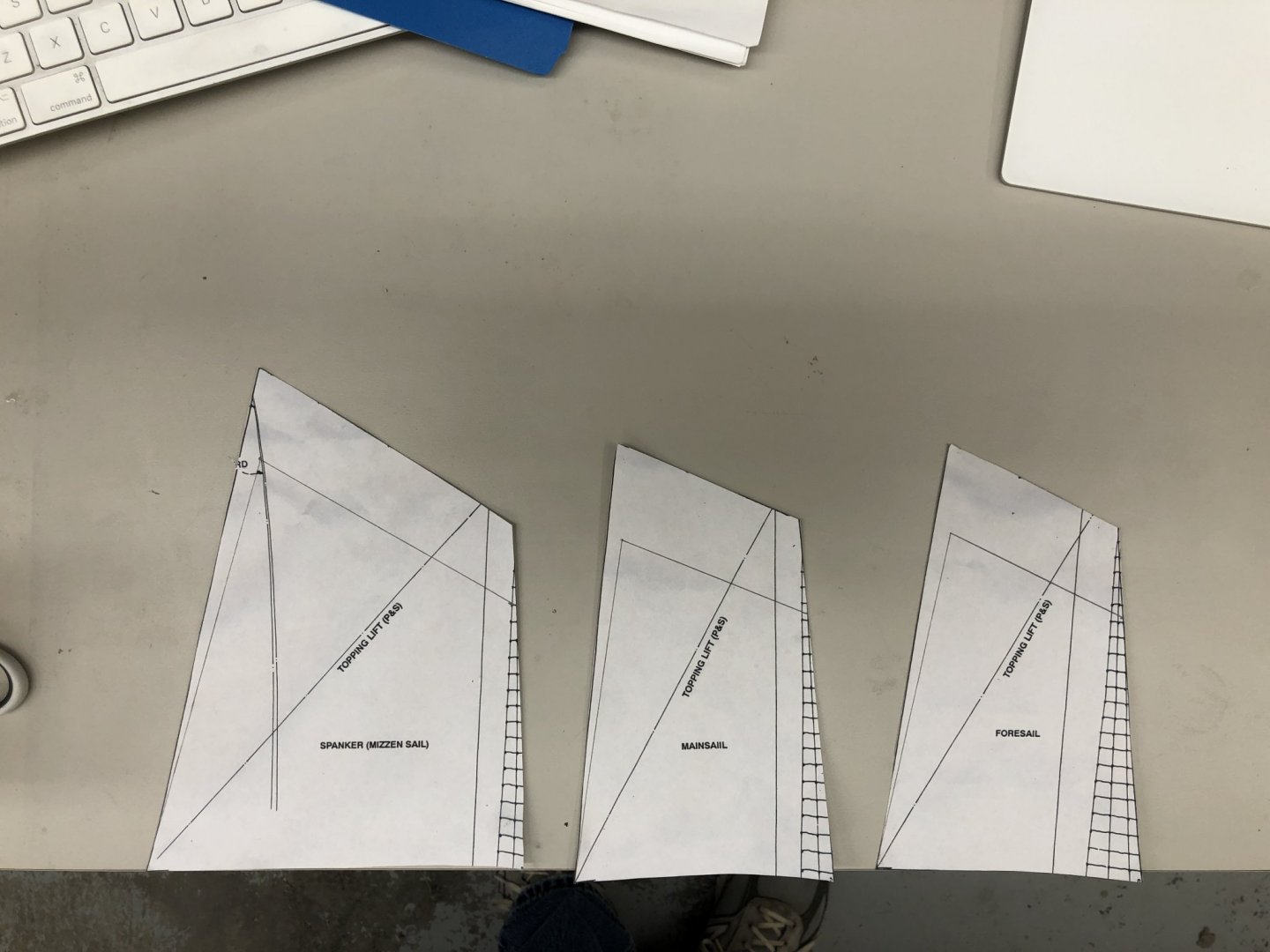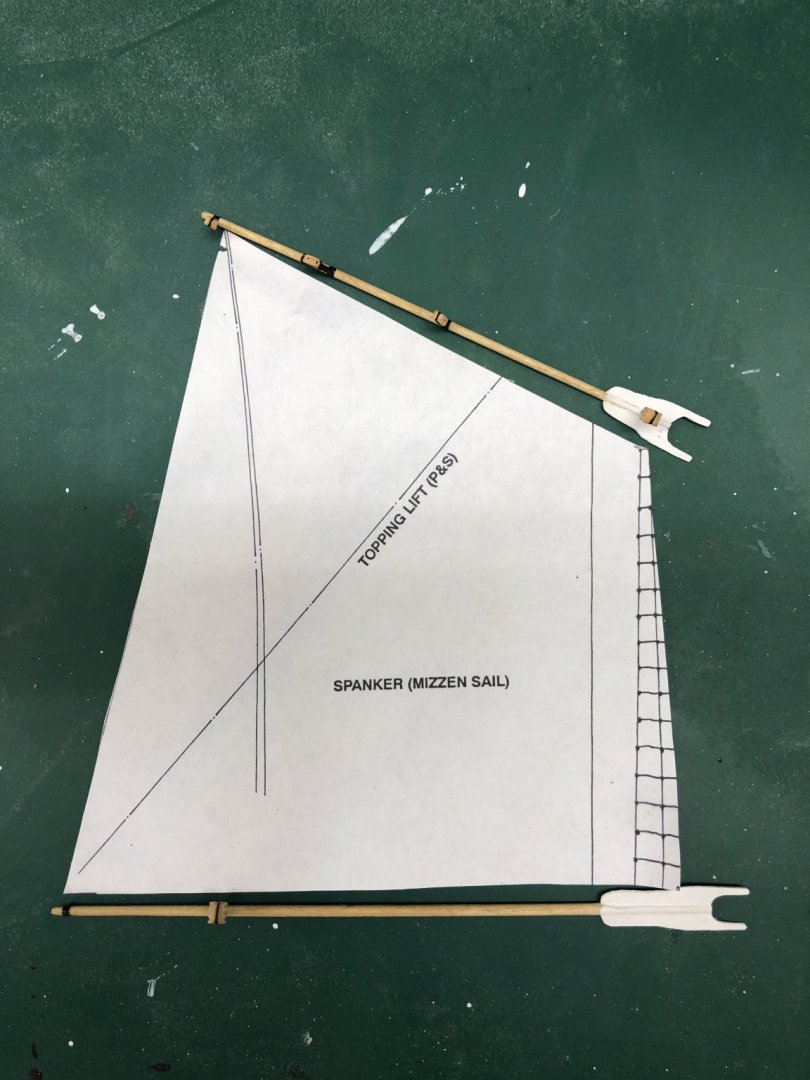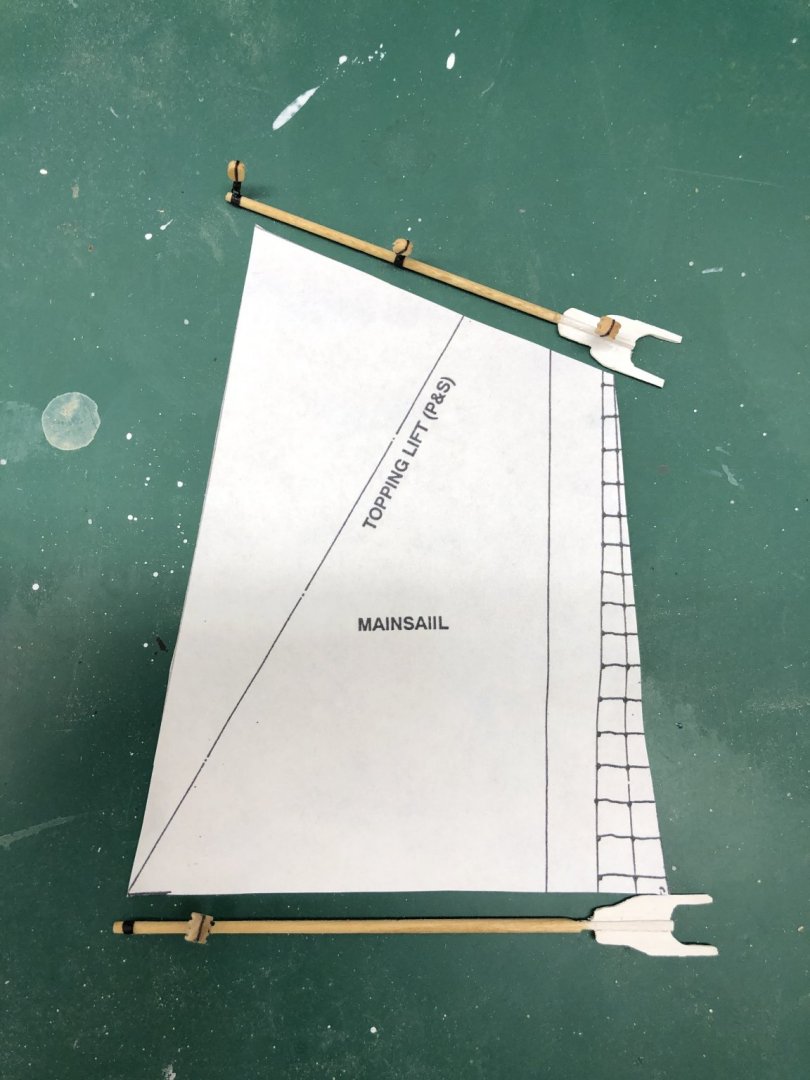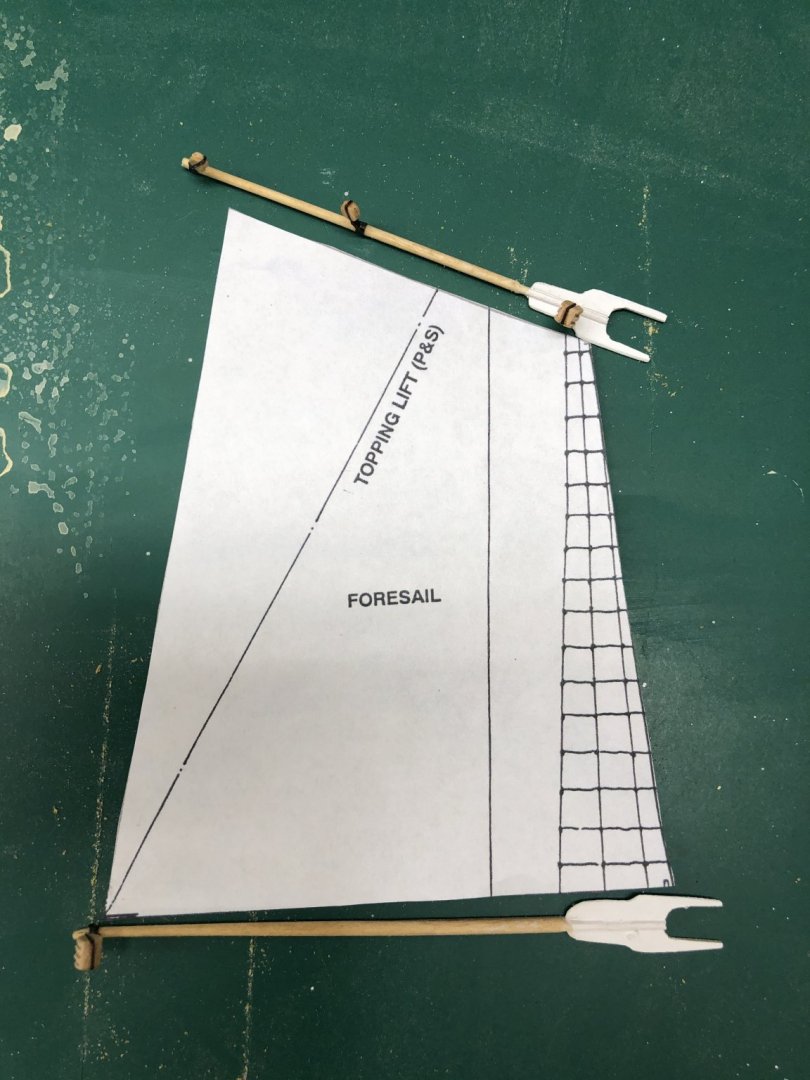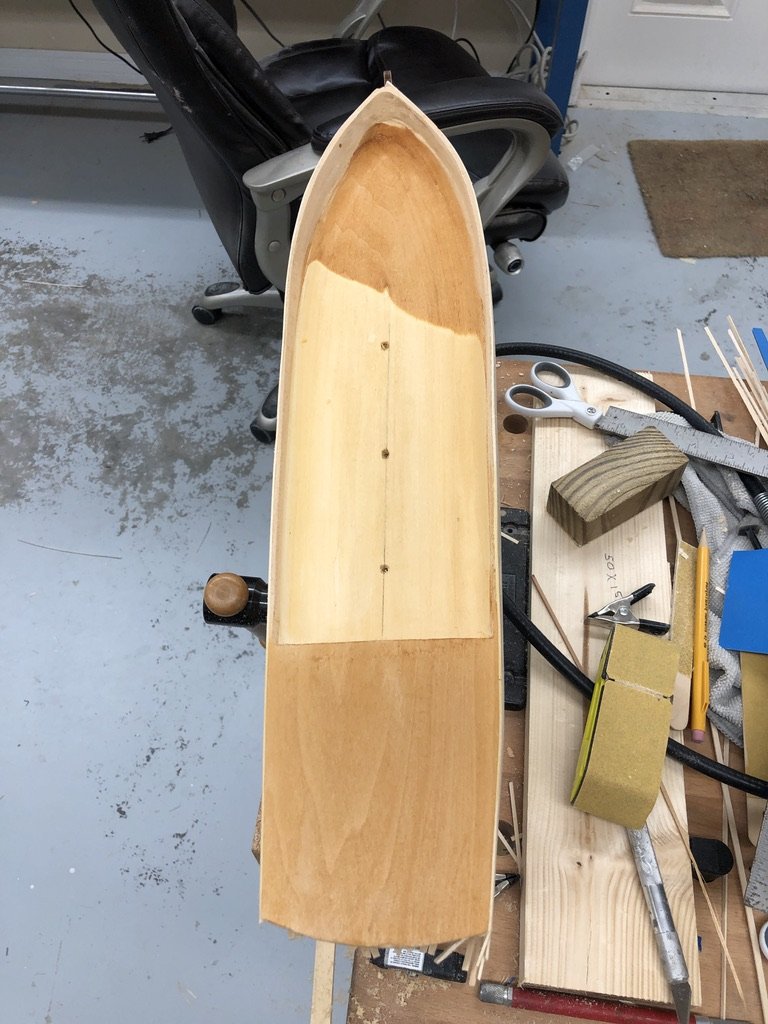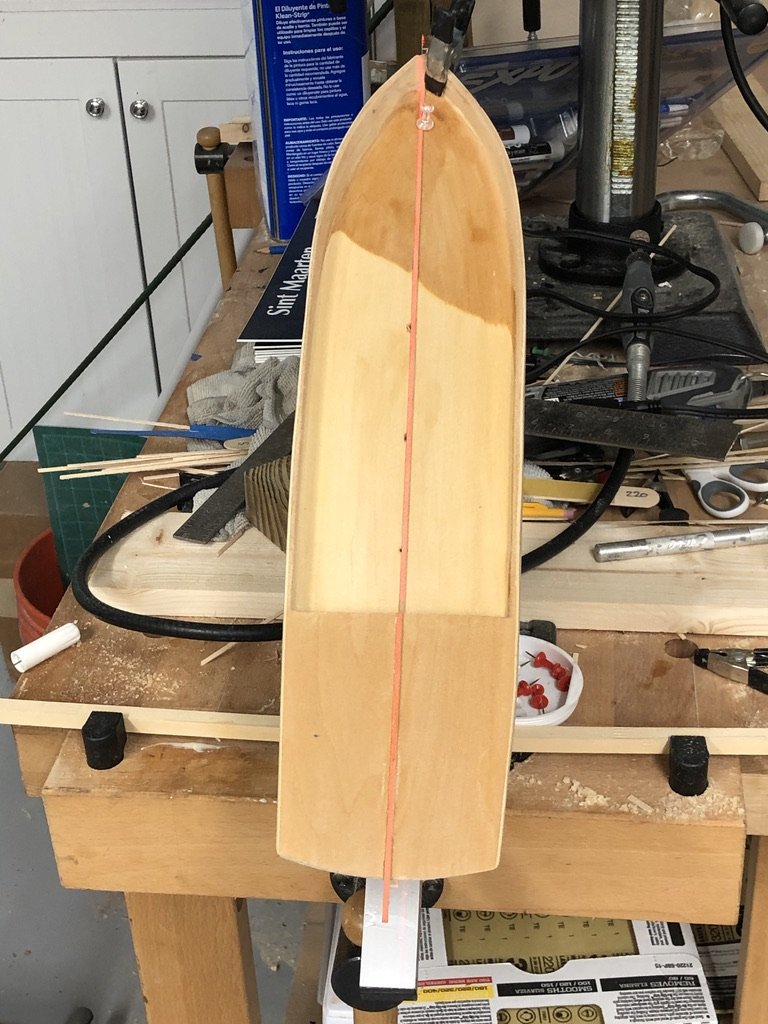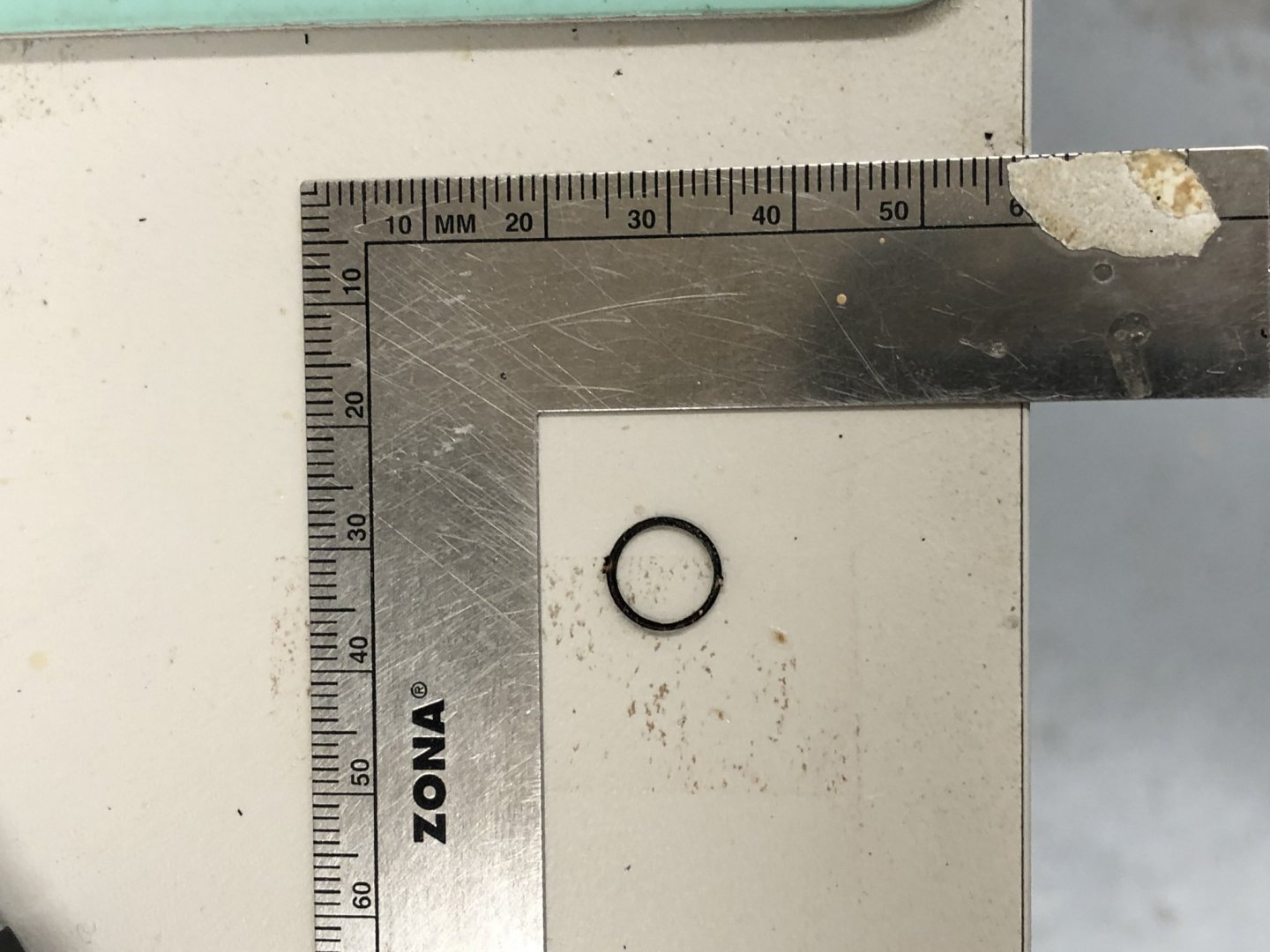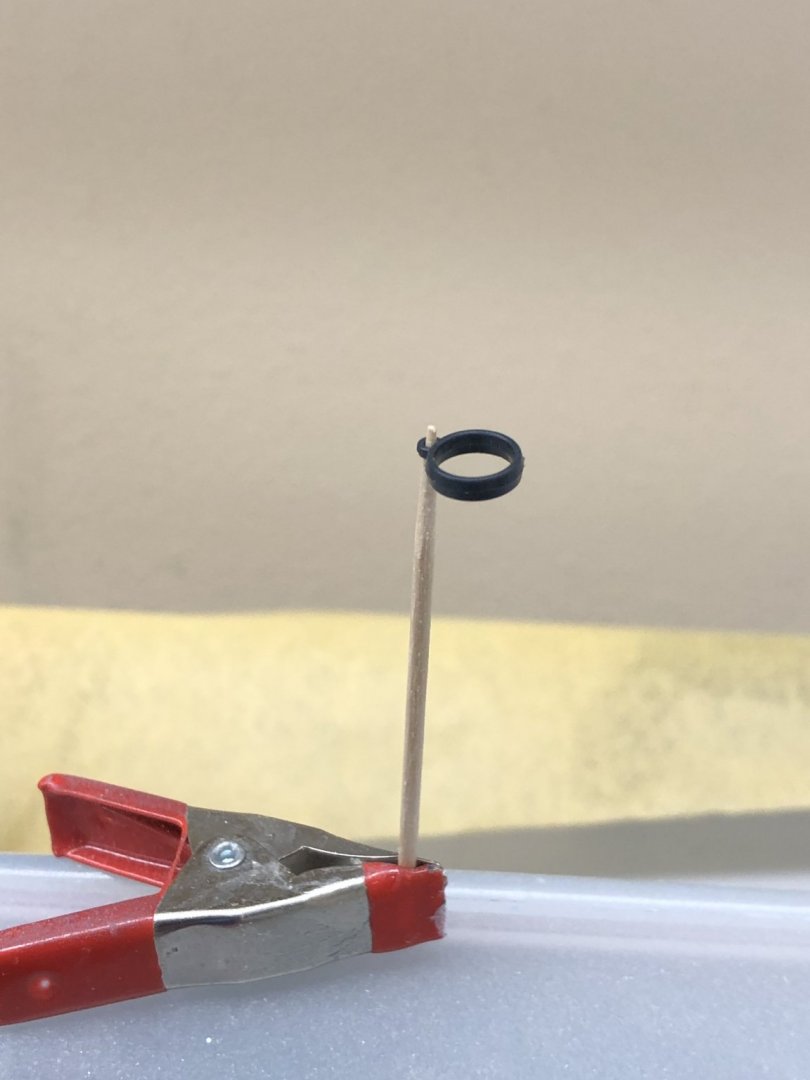-
Posts
1,915 -
Joined
-
Last visited
Content Type
Profiles
Forums
Gallery
Events
Everything posted by cdrusn89
-
Continuing to "fiddle around" I completed the lower Mizzen mast adding the tape (aka metal bands - and added a backing plate for the throat halyard triple block) and the peak halyard and topping lift blocks. Fore and Main masts are next. Thinking about adding serving to the center parts (to just below the bolster) for the lower shrouds. I used the Syren Serving machine for the much more extensive serving on the Niagara so I know what is required. Just wonder if that is "going overboard" at 1/96 scale. The instructions (page 13 - sketch 17) appear to show serving on the lower shrouds and forestay. Something to think about.
- 166 replies
-
- fannie a gorham
- finished
-
(and 1 more)
Tagged with:
-
Worked on the stern taffrail to see how the wooden pillars would look. I fabed the top (1/16" thick) and the bottom (3/32" thick) and then marked where the pillars should go (3/16" spacing as best I can tell from the drawing) on each piece. To make sure I have the locations in the same place top and bottom I used a drill press to drill a small (#70) hole through both pieces while keeping them clamped together. I glued every other pillar to the bottom rail and then the intervening ones to the top rail remembering that the pillars have a top (not symmetric). When that dried I joined the two pieces together using some machinists squares to provide some weight and (hopefully) everything would line up. In the end I had to move one pillar to get the spacing closer to the desired state but overall it looks okay. Here ius how it looks now after a coat of primer (which is almost white).
- 166 replies
-
- fannie a gorham
- finished
-
(and 1 more)
Tagged with:
-
I decided I did not like the ship's wheel provided (Britannia metal again). I looked around and found a wooden wheel at Model Expo that is only a little (1/8") bigger in diameter than the one provided. The real issue with the Model Expo one is width, at scale it would be over a foot thick - not very realistic. Still it probably would look better than I could every get the Britannia metal one to look so I thinned it down some (still almost 1/8" thick) and painted it with gloss clear. Here is the completed wheel box sitting on the quarterdeck.
- 166 replies
-
- fannie a gorham
- finished
-
(and 1 more)
Tagged with:
-
I am still working "odds and ends" waiting for paint to dry. Given my dislike of Britannia metal fittings I decided I had to do something different with the taffrail stanchions. I purchased some wooden (not sure what kind of wood - not that it matters much since they will be painted white) pillars which are 6mm tall which as you can see below is a bit taller than the ones supplied in the kit. I cut the pins off the kit stanchion and it measures 5mm (.04") So I have to decide to just substitute them and not worry about the approx 3/64" difference in length (more than 1/16 but less than 3/64s) which would be about 8" at scale. I have my doubts that it would be that noticeable if I did nothing but I decided to thin down the base of the railings from the 1/8 (at the stern) and 5/32 (on the sides) to 1/16 and 3/32 respectfully to get back 6" of the overage. I will probably have to use the thickness sander to get something 5/32" as nothing supplied in the kit is that thickness. Although the paint is not yet completely dry I could not resist trying the deck furniture (such as it is) "on for size". So here are two shot sof what I have done so far.
- 166 replies
-
- fannie a gorham
- finished
-
(and 1 more)
Tagged with:
-
Still working the deck furniture (hard to stop once I get going). Here are the two hatch coamings after assembly, one coat of primer and a 220 sanding. I think I did a fairly good job getting them the same width. The main hatch is slightly (1/8") shorter than the drawings as I fear with my lifeboat being somewhat wider than the one on the drawing there may be an issue. I have all the other structures completed and in the paint shop. Will get pictures when they are "ready for prime time".
- 166 replies
-
- fannie a gorham
- finished
-
(and 1 more)
Tagged with:
-
Fiddling around while the paint dries. I shifted from water based acrylic to enamel and it takes at least 24 hours (usually more like 48) for the enamel to dry - but it usually only takes one coat (over the primer which for some reason dries much faster) to cover where it was taking 3-4 coats of the acrylic. I am probably doing something incorrectly but have no idea what. Anyway, I decided I did not like the Britannia metal boom rests that came with the kit. They seem a bit "clunky" and I have never had much luck getting them painted to my satisfaction so I decided to make my own. I started with some mast hoops (1/4" in this case) which are just a bit bigger than the lower masts. These are from Bluejackets and seem to have more than the usual amount of laser char and are 1/32" thick. I stacked three of them together to make a 3/32" thickness (thin CA) and then tried to remove as much of the char as I could without crushing the who;e thing. The individual hoops are quite fragile but three together is much stronger (dah). Using this as the base I cut pieces of 1/16" X 1/32" strips into pieces 1/4" and 1/8" long and glued them together (again thin CA) to form an "h" the shorter piece on top on the longer. I made three of these and glued (wood glue this time) the thinner portion of each to the outside of the hoops evenly spaced around the hoop. Once dry I rounded what would be the lower (thicker) end of the support piece and test fit it on the mast. It will, of course, look better painted but I think I will make two more and consign the kit parts to my "orphan parts bin". FYI - on my way to Minneapolis for my yearly dose of really cold weather - coming back on Tuesday - four days is all I can take.
- 166 replies
-
- fannie a gorham
- finished
-
(and 1 more)
Tagged with:
-
Home with new car and the skylight is complete (except for acetate and paint (not in that order). After several instances of getting most of the holes drilled in the 1/32 boxwood frame and then having the wood splinter or otherwise misbehave on one of the last holes, I stated using a #78 drill first and then widening it with the #76. That seemed to work better but the pieces of the frame, which are about one inch long with seven holes removing almost half the wood the are fragile. I got two more completed and the wire installed and then glued both in place on the previously assembled frame. Here is how it looks. I decided to cut a hole in the roof of the deck house instead of painting the roof black under the skylight. I will see how it looks when in place and may then decide to paint most of the deck under the aft deckhouse black if it shows "too much".
- 166 replies
-
- fannie a gorham
- finished
-
(and 1 more)
Tagged with:
-
Going off line for a few days to pick up new car in South Carolina.
- 166 replies
-
- fannie a gorham
- finished
-
(and 1 more)
Tagged with:
-
Working the skylight for the after deck house. I fabed the framework using end pieces of 1/16" basswood and templates from the plans. The sides are 1/16 X 1/8 strips and the center is 1/16 X 1/4 sanded down to 7/32. Now for the brass rod bars across the "windows". My first thought was cutting a frame from the 1/32 strip wood and gluing short pieces of the 1/64" brass rod provided across the opening. I did that but the 1/32" sheet split when I tried to cut from the larger piece it was part of. The 1/32" strip wood is quite fragile along the grain line, especially when trying to cut it with a razor knife (Xacto et al). So I rummaged through my wood pile and found some 1/32" plywood (three plies) that I used for something (I forget what) and redid the the frame opening and added the wires to that. The wires are glued on with Weldbond which will dry clear so it will not be as noticeable as it is now and maybe it will look okay when painted white per the instructions. After looking at the problem a bit more I decided to try another approach. I have some 1/32 X 1/32 (.031125") boxwood and thought if I could drill a hole (in the center) big enough to get the brass wire (.019") through (without breaking it) it might be a better looking solution (no glue "bumps". So I tried. Getting the holes (.020" - #76 bit) drilled in the center is a challenge but I found using a sharp awl to mark the hole location made it easier (but not easy) to get the hole centered and not wander off. I decided on seven bars per window so needed two pieces with seven holes each. It took some time but I finally got one set assembled. I used thin CA to "seal" the wire in the wood. I need to trim the lower bar and make another set but I think this is the way I am going to go for the skylight.
- 166 replies
-
- fannie a gorham
- finished
-
(and 1 more)
Tagged with:
-
I am continuing to work the deck furniture as I am having trouble staying motivated working on the masts. I did get the transom installed. After rereading the instructions and careful study of the limited drawings I think the transom is supposed to extend up so the top of the transom piece is even with the top of the taffrail waterway. For whatever reason, probably my not shaping the stern correctly, the provided transom is too short to cover both the taffrail waterway and the stern planking. So the taffrail waterway will run on top of the transom and then the taffrail bottom rail on top of the waterway. I am guessing no one will notice. Anyway, here is the hull with the primer painted forward deck house and the in-process after deck house along with the completed lifeboat.
- 166 replies
-
- fannie a gorham
- finished
-
(and 1 more)
Tagged with:
-
The forward deck house assembly is complete except for the stove exhaust (I think). The side view on Sheet 3 seems to show a sliding hatch but it does not show on the plan views on sheet 3 or 1 so I guess there is not one. Here is the fwd deck house after the primer coat.
- 166 replies
-
- fannie a gorham
- finished
-
(and 1 more)
Tagged with:
-
I finally have one thing "done". Here is the lifeboat in its cradle and lashed down on the deck approximately where it will be on the finished model. For those interested this is the 2 1/8" boat kit from Model Shipways with HO scale 1" X 8" boards from Northeastern Scale Lumber glued on the solid hull to get the clinker "look".
- 166 replies
-
- fannie a gorham
- finished
-
(and 1 more)
Tagged with:
-
I was having so much playing with my furniture building jig I went and assembled the aft deck house too. Somewhat more challenging since it is not rectangular and without a plan of what it looks like at deck level (the plan view provided shows the roof outline) I had to come up with another way to get the correct shape. My method was to rubber cement copies of the deck house drawings to the 1/32" sheet provided and sand the sheets to the lines representing the top and bottom of each side, disregarding the camber in the fore and aft pieces (straight across the bottom). I then marked the measured centerline on the fore and aft pieces and drew a line perpendicular to the wall of the furniture jig (red in picture). I clamped the forward end to the wall of the jig with the center on the red line and then used the magnetic "clamps" to position the aft end on the centerline approximately where it would be. I used the two side pieces to establish exactly where the aft end should be and used more magnetic clamps to hold them in place against the end pieces. I carefully moved the pieces apart one at a time and added wood glue to the joints and then made one last check that everything looked "trapezoidal". I will remove the drawings from the wood after I cut out where the windows go. Note that one side has the plan on the inside since the drawing shows only one side of the structure. I drill holes from the inside to locate the top of the window opening so I can cut them on the outsiude. Here is the aft deck house ready to have the roof installed.
- 166 replies
-
- fannie a gorham
- finished
-
(and 1 more)
Tagged with:
-
I installed the waterways, including my somewhat indifferent attempt at scarf joints. I was not too concerned about the junction at the bow as this will be hidden under the bowsprit. I did not install the stern waterway yet as it is not clear to me from the drawings whether the transom piece extends to the top of the waterway or ends at the top of the deck planking. In fact the entire stern layout is confusing. The instructions (page 5) call for a 5/16" wide waterway at the stern with the 1/8" wide taffrail base on top but the drawing (sheet 1 - Plan View) only shows (as best I can tell) the taffrail base. Admittedly there is only 1/16" of the waterway protruding forward of the taffrail base but it should show on the plans somewhere. My plan is to install the transom even with the top of the quarterdeck decking now and have the waterway extend over the transom piece (to cover the seam between the transom and the decking and any sanding marks made getting the transom even with the decking). Probably should have don this before I put the Wipe-on-Poly on the quarterdeck but that is how you learn. So here is the hull with the waterways (except at the stern) installed.
- 166 replies
-
- fannie a gorham
- finished
-
(and 1 more)
Tagged with:
-
Continuing to work on the fwd deck house. I used the kit provided 1/32" sheet deck planking for the roof - it will be painted gray. The sides I plan ked with left over hull planking strips (1/32" X 3/32". I had to muse a few smaller pieces when necessary around the windows. Here it is with the front and one side ready for primer. The sides of the deck houses will be white like the inside of the bulwarks and waterways. When I looked at the aft deck house I realized that the windows I made from forward will be too big aft so I found my "window jig", and am making another set about half as tall as the ones on the fwd house.
- 166 replies
-
- fannie a gorham
- finished
-
(and 1 more)
Tagged with:
-
Speaking of deck houses - here is the forward deck house "going up" in the furniture building jig. I used the disk sander to take the 1/32" sheet with the deck house outline rubber glued to it down to the lines. I did the forward one first because it is square and therefore requires less thought. I will cut out the windows and add the additional "siding then the structure is more secure (like has a roof) and maybe a floor (painted black)
- 166 replies
-
- fannie a gorham
- finished
-
(and 1 more)
Tagged with:
-
Deck planking is complete - four coats of Wipe-on-Poly with 320 grit sanding between coats. Waterways will be installed next then paint the bulwarks (waterways act as "splatter shield" while bulwarks are painted - hopefully).
- 166 replies
-
- fannie a gorham
- finished
-
(and 1 more)
Tagged with:
-
I started looking at the deck houses and found some inconsistencies on Sheet 3. The overhead view and the side views do not match up dimensionally. The sides are all noticeably (2-4mm) shorter than the overhead. And then I realized the overhead includes the roof overhang. So the drawings are correct as drawn - I should have known.
- 166 replies
-
- fannie a gorham
- finished
-
(and 1 more)
Tagged with:
-
The quarterdeck was even easier- cut strips to five inches and glue them on. Once dry trim to match transom and forward edge. No issues (at least that I have noticed so far). Here is the completed cherry decking after 220 grit sanding and wiped with paint thinner.
- 166 replies
-
- fannie a gorham
- finished
-
(and 1 more)
Tagged with:
-
Using 1/32 X 3/32 cherry strips from Northeastern Scale Lumber I planked the fore deck. When I got to the outboard area I had to use a 17 Xacto blade (heavy chisel) to square off the junction between the bulwark and deck. Apparently I did not do too good a job the first time around. I used graphite from a carpenters marker (you know the orange ones they sell at Home Depot) to darken one edge of each plank before installation. I tried to pay attention to the junction with the quarterdeck as there is only a 1/32" sheathing on the face to hid any gaps between the deck and the bulkhead. At the bow there is at least the 3/16" waterway to cover up any errors and the bowsprit will cover the center part too. Anyway, there were no surprises in getting the deck planked. I used full length strips every where (no plank butt junctions) as there is quite a bit of the deck hidden under deck furniture and such so that it did not seem worth the effort. I also cut and fitted the waterway for the fore deck. It is just laying in place in the picture. It will be painted white and installed after the deck is sanded and finished (Wipe-on-Poly satin). I put one coat of Wipe-on-Poly on the waterways - hopefully this will keep the wood grain from standing up when it is painted. I am trying to avoid it looking like my cross trees on the Fore Mast. What ever became of the sanding sealer they sold for use on balsa wood airplanes? So here is the sanded foredeck with and without the water ways.
- 166 replies
-
- fannie a gorham
- finished
-
(and 1 more)
Tagged with:
-
I read somewhere that there is a U-Tube video on making sails from silk span. I watched it last night. My previous experience (based on an Admiralty Models class given in 2014) prepared the silk span by repeatedly applying a very dilute mixture of artists acrylic paint (out of the tube) and water, letting the silk span dry between applications. This takes a considerable period of time (at least for me) as it took 5 - 7 applications to get the silk span almost opaque and an acceptable color. The U-Tube applies the paint full strength using a foam paint roller. It dries in about 4 hours and you have a piece of silk span read to lay out the sail. Much faster and since I plan to have the sails furled the quality of the paint job (although this looks to provide a more even color than my previous method) is not of primary importance. Below is a picture of the first piece of silk span I made using the U-Tube process. Based on my experience with the Latham's sails I decided to reduce the height of the sails to 4" (from 5.25 approx) to reduce the amount of material that has to be furled. I modified the sail plans that I had cut from copies of the drawing to shorten the leech but maintain the length at the head so it will still fit the gaff. I then cut out the new sail outline and laid it out with the appropriate boom and gaff to make sure there would be no issues once it came time to actually mount the sails on the spars. I was somewhat apprehensive about this issue because the sail plan does not explicitly show where the forward edge of the sails are located. The shrouds and mast lines all run together and the offset you would expect between the mast and the sail is not obvious. From the pictures below the mizzen appears to be "okay" (I have to boom to far forward so there should be enough room at the aft end of the boom). The main appears to have a small issue - I need to make the sail a little shorter at them foot. Similarly on the fore. I need to check the dimension on the fore gaff (or the Foresail) - the gaff looks to be too long.
- 166 replies
-
- fannie a gorham
- finished
-
(and 1 more)
Tagged with:
-
I finished thinning the bulwarks and putting some (but not all) the camber on the deck. The plans only give you the cross section at the forward end of the quarterdeck where you can see how much camber is at that point. I doubt it is that way all the way forward. Anyway I sanded in as much as seemed reasonable and called it a day. I put a coat of Wipe-on-Poly on the hull and got out my laser level. I used the level to get a straight line from the stem to the measured center at the stern and then laid a thin line of wood glue down that line. I am using 1/32" X 3/32" cherry to plank the deck so I used the laser line to get a piece down the center of both decks. Planks that thin will wander all over the place if you do not have some reference. Once these dry I will continue planking the deck. I am still on the fence about whether or not to simulate the caulk between planks. All the previous decks I have done the decking was lighter than this cherry and the caulk showed up pretty well. I am not sure it would be worth the effort here. My previous experience was with using pencil lead on the plank edge to simulate the caulk but that was all on planks at least 1/16" thick. At 1/32 getting enough graphite on the edge to show up may be an issue. So here is the hull with the poly applied and with the centerline deck planks installed.
- 166 replies
-
- fannie a gorham
- finished
-
(and 1 more)
Tagged with:
-
Since I have started getting serious about adding furled sails (and thinning the bulwarks is going soooo slowly) I decided to see about mast hoops. I got an order from BlueJackets of their hoops in 1/4" and 5/32" both of which are 1/32" thick. They may not work out - I broke three of the first four 5/32" ones getting them out of the carrier sheet. They are VERY fragile. I broke the one I successfully got out of the carrier trying to sand off the the area where it connected to the carrier. Assuming I can get 30+ successfully off the carrier and the nubs sanded off I still think they are too fragile to survive being attached to the sail. Here is a picture of the one (second picture actually) I successfully removed before I tried to sand off the "nub". So I looked through my "boxes of parts" and came across plastic mast hoops that are 7mm (inside) diameter which is pretty close to 1/4" (.275 to three decimal places). And it has a ring where the sail would attach. Probably not what the Fannie used but much of the detail of the attachment is covered up by the furled sail. That is the good news - the bad news is the plastic hoops come is a color that is somewhere between blue and gray, close to a Navy blue color and are 3/32" thick. (first picture) So I took one and ran it across a sanding stick a dozen times on each side and painted it a buff color and I think this will work. I order 40 more (just to be on the safe side) from Billings Boats. They have them in brass also but I do not think thinning the brass ones will be as easy as the plastic ones - and the brass ones are not completely closed. (you can probably figure out which picture this is)
- 166 replies
-
- fannie a gorham
- finished
-
(and 1 more)
Tagged with:
-
My original plan for the Futtock shrouds was to have eyebolts on the mast with wire leading up through holes in the cross trees with an eye formed in the end of the wire to be the belay point for the top mast shrouds. No plan survives first contact with the enemy as they say. The first problem was getting the correct size wire. I started with 30 gauge (.013") black wire from a craft shop. I was never able to get a really satisfactory eye in the end that went above the cross trees - it was always too long, with the wrapping extending well below the cross trees or the wrappings were too uneven and too long. That and I was unable to figure out a way to attach the wire to the eyebolt in the mast while tensioning the wire straight. Soooo. I pulled the eyebolts out of the mast and used the black striping tape I used on the spars to make a simulated metal band where the eyebolts had been. I switched to 24 gauge (.020") wire and form a simple eye in the upper end. That and instead of a hole in the cross tree, I cut a slot from the outer end to the hole i had already drilled so the wire can slide in. I drilled holes through the striping tape (puncture a hole through the tape with something sharp first - do not try and drill through the tape directly unless you are using a really small (#76 or 78) drill bit; don't ask me how I know. Here is what it looks like now. Wire could be straighter and the eyes look a little on the large side but I think these will do. Now for the other two masts.
- 166 replies
-
- fannie a gorham
- finished
-
(and 1 more)
Tagged with:
About us
Modelshipworld - Advancing Ship Modeling through Research
SSL Secured
Your security is important for us so this Website is SSL-Secured
NRG Mailing Address
Nautical Research Guild
237 South Lincoln Street
Westmont IL, 60559-1917
Model Ship World ® and the MSW logo are Registered Trademarks, and belong to the Nautical Research Guild (United States Patent and Trademark Office: No. 6,929,264 & No. 6,929,274, registered Dec. 20, 2022)
Helpful Links
About the NRG
If you enjoy building ship models that are historically accurate as well as beautiful, then The Nautical Research Guild (NRG) is just right for you.
The Guild is a non-profit educational organization whose mission is to “Advance Ship Modeling Through Research”. We provide support to our members in their efforts to raise the quality of their model ships.
The Nautical Research Guild has published our world-renowned quarterly magazine, The Nautical Research Journal, since 1955. The pages of the Journal are full of articles by accomplished ship modelers who show you how they create those exquisite details on their models, and by maritime historians who show you the correct details to build. The Journal is available in both print and digital editions. Go to the NRG web site (www.thenrg.org) to download a complimentary digital copy of the Journal. The NRG also publishes plan sets, books and compilations of back issues of the Journal and the former Ships in Scale and Model Ship Builder magazines.



